For the first time, the NFL held the first round of its annual draft virtually as teams made their picks from locations across the country because of the COVID-19 pandemic.
Thirty-two players found out which NFL teams they’ll be playing for this season. After months of anticipation and countless mock drafts, Thursday’s NFL draft ushered in a new class of players poised to be game-changers for their respective teams for years to come.
The second and third rounds will take place Friday, with rounds four through seven set for Saturday.
Justin Herbert gives Chargers presence, but to make it in L.A. he’ll need to win
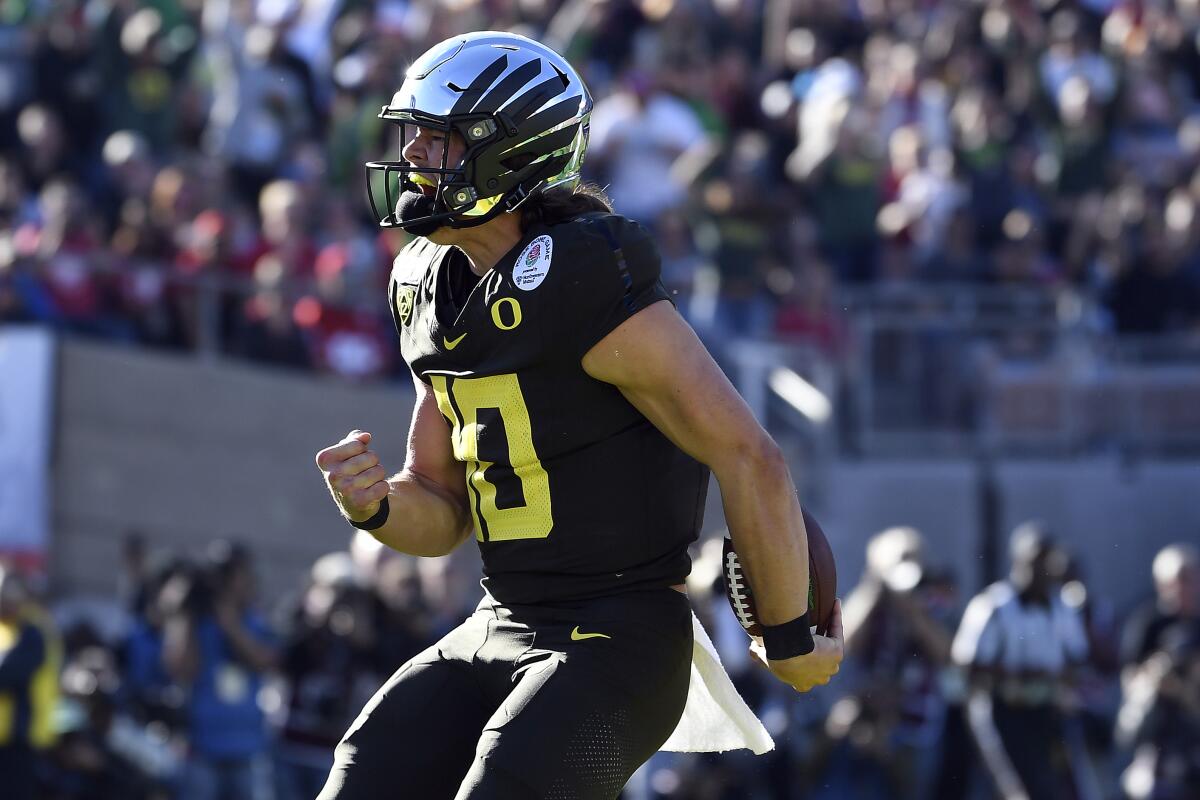
The first thing you notice about Justin Herbert, as I did when he ran past me in the tunnel after this year’s Rose Bowl, is his presence.
He’s huge. He’s solid. He looks like a tight end.
He looks, in fact, exactly like what the Chargers need, which is why it was so fortuitous they selected the Oregon quarterback with the sixth overall pick in Thursday’s NFL draft.
He looks like a cornerstone. He plays like a foundation. He was the perfect pick.
“This is such an incredible opportunity, words can’t describe how excited and thrilled and fired up I am for this opportunity,” Herbert said in a video conference call with reporters. “I am going to do everything I can to be the best quarterback I can be, everything I can for the city of Los Angeles.”
For the record, he will carry the Chargers into their new post-Philip-Rivers, Sofi-Stadium era on a 6-foot-6, 236-pound frame that can throw the heck out of the deep ball.
Also, for the record, he is not Tua Tagovailoa, and that is not necessarily a bad thing.
Kansas City Chiefs draft LSU running back Clyde Edwards-Helaire at No. 32
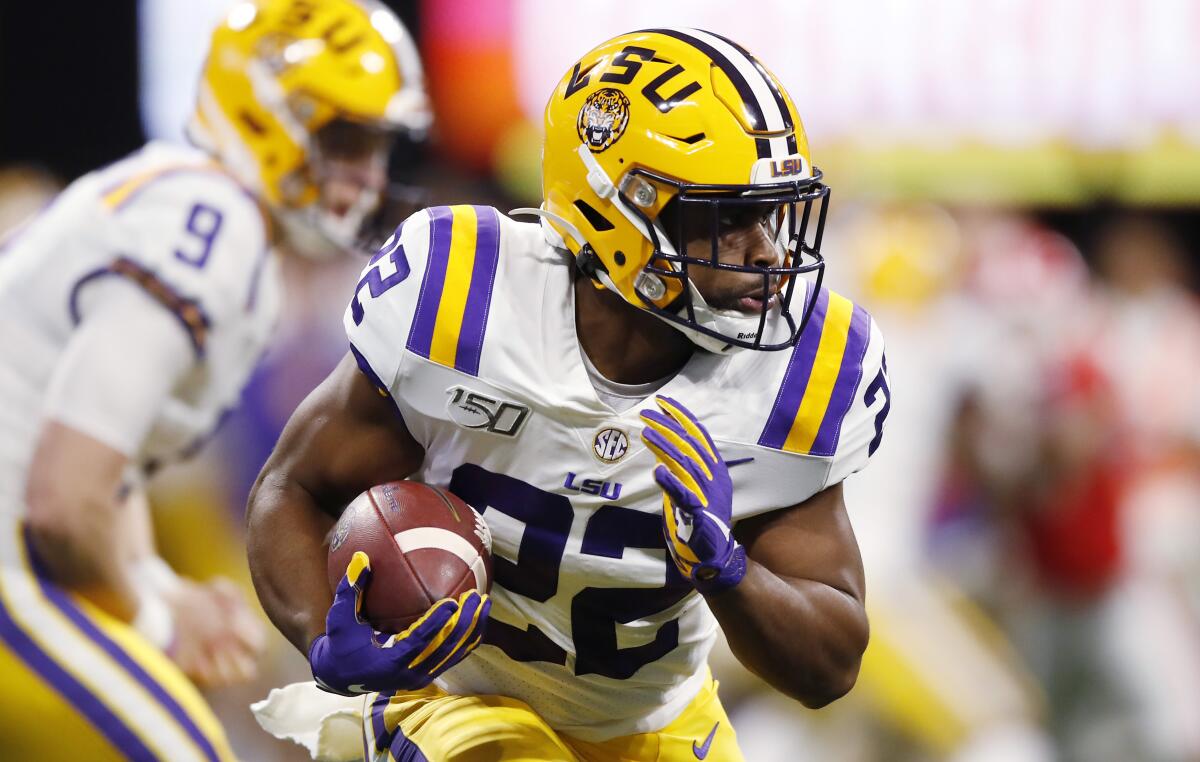
Clyde Edwards-Helaire runs low to the ground with the power and balance to break tackles, the agility to juke away from them in tight quarters and the breakaway speed to rip off long gains. He rushed 215 times for 1,415 yards and 16 touchdowns, caught 55 passes for 453 yards and one score and returned 10 kickoffs for 214 yards for the national-champion Tigers in 2019, prompting Heisman Trophy-winning quarterback Joe Burrow to call Edwards-Helaire the team’s best athlete.
Farmer’s take: The Chiefs somehow won the Super Bowl having to fake it at running back for much of the season. Edwards-Helaire is short, swift and shifty.
Minnesota Vikings draft TCU cornerback Jeff Gladney at No. 31
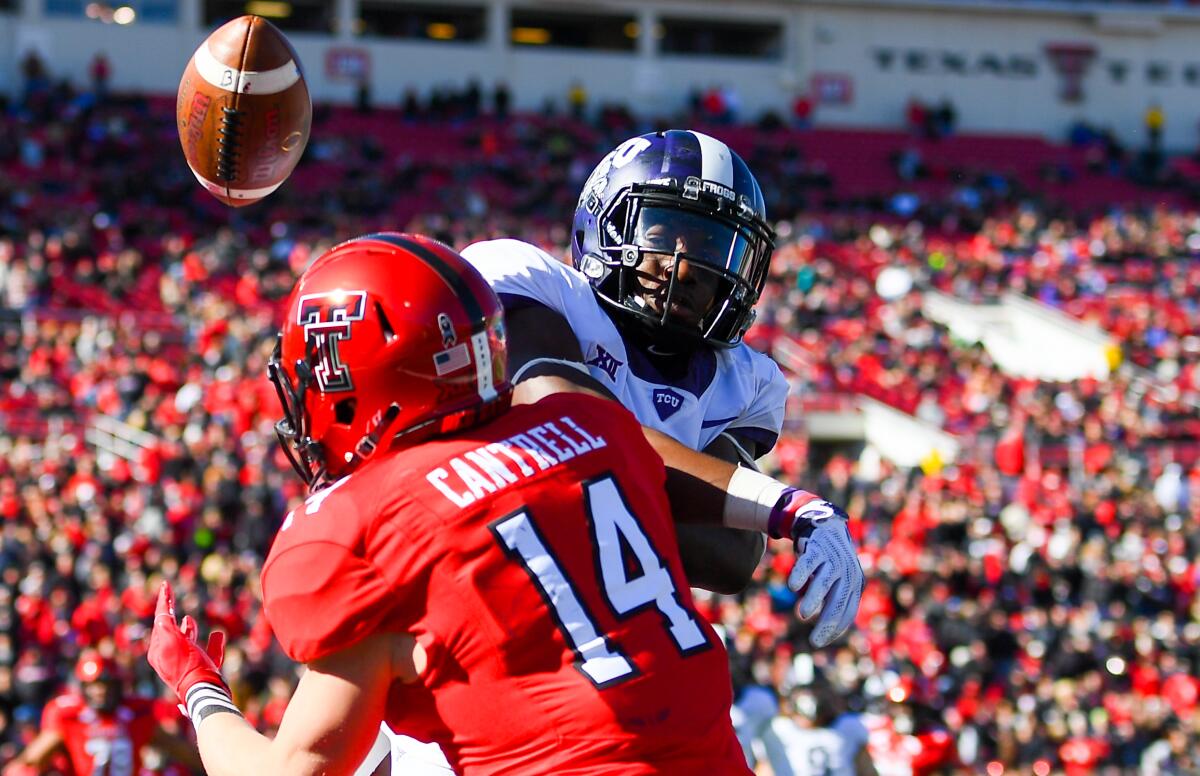
Jeff Gladney has the quick-twitch athleticism and route anticipation to stick with receivers in press coverage and the ball skills to contest a high percentage of throws. His size and slender build, his 6-foot-3 wingspan and 37 ½-inch vertical leap may cause matchup problems against some of the NFL’s bigger receivers, but coaches and scouts love his tenacity — Gladney, who led the Big 12 with 14 pass-breakups and had one interception in 2019, backs down from no one.
Farmer’s take: Mike Zimmer has always had good corners, but last year was a bad season in that regard. Gladney isn’t big, but he’s got great feet and is really technically sound.
Miami Dolphins select Auburn cornerback Noah Igbinoghene at No. 30
The son of two Olympic-caliber track athletes from Nigeria, Noah Igbinoghene began his college career as a receiver while serving as the team’s primary kick returner (25 for 571 yards, a 23.8 average) in 2017. The stocky but explosive Igbinoghene moved to cornerback in 2018, posting 92 tackles and 18 pass-breakups and returning 20 kickoffs for 628 yards (31.4 average) in 2018 and 2019. He is expected to improve with experience but should offer early special-teams help.
Farmer’s take: Both of his parents were Olympians, track stars for Nigeria. Teams can never have too many good cornerbacks, but the Dolphins are loaded with Byron Jones and Xavien Howard.
Tennessee Titans select Georgia offensive tackle Isaiah Wilson at No. 29
Another big-name tackle is off the board. Isaiah Wilson established himself as one of the top tackles in the nation at Georgia despite being limited last year with an ankle injury. He still did enough to be named a second-team All-American.
Farmer’s take: The second Bulldogs offensive lineman comes off the board. The Titans were groping for a capable right guard last season, as neither Jamil Douglas nor Nate Davis cut it.
Baltimore Ravens select LSU linebacker Patrick Queen at No. 28
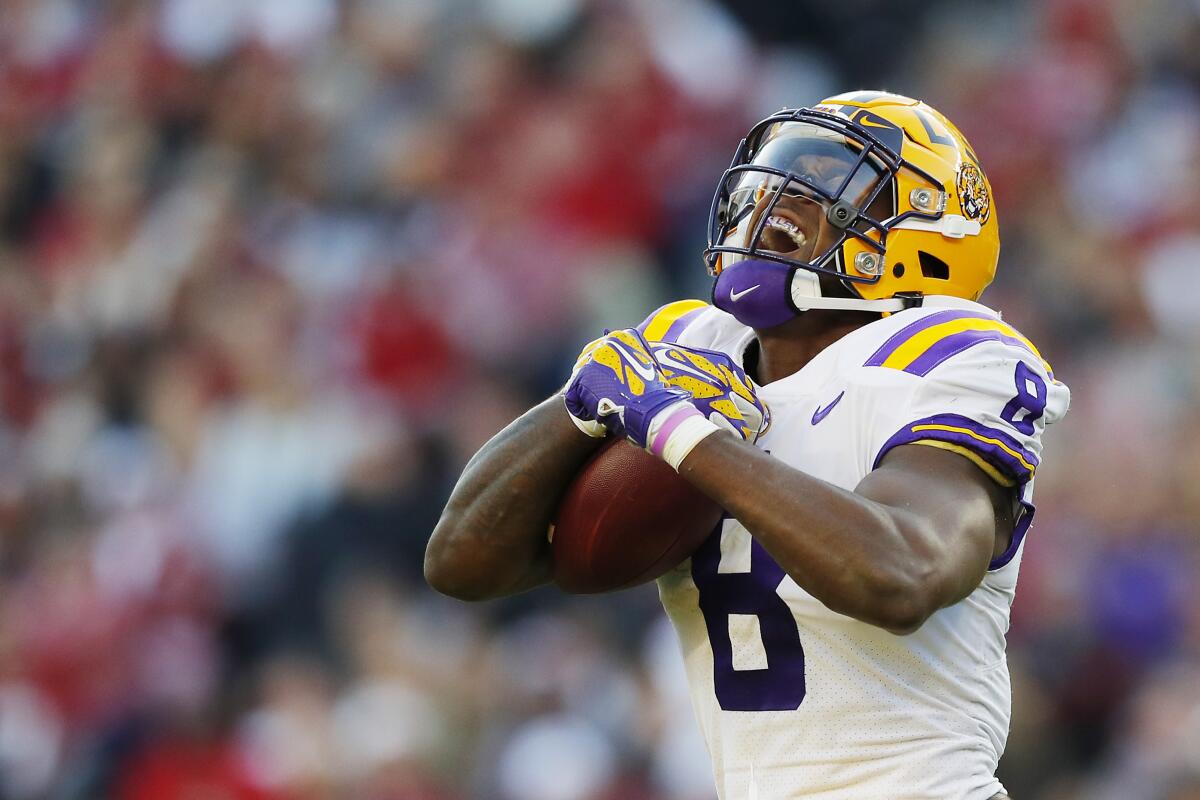
Patrick Queen is small for a linebacker and didn’t earn a starting role for the Tigers until the fourth game of his junior season. But he became a vital part of an LSU team that went 15-0 and won the national title, posting 85 tackles, 12 for loss, three sacks, an interception and two pass-breakups. His speed and quick recognition were on display in LSU’s last three games, when he had 21 tackles, five for loss, against powerhouses Georgia, Oklahoma and Clemson.
Farmer’s take: Middle linebacker is a glamour position in Baltimore, and Queen is up to that challenge. It marks the first time the Ravens have drafted an LSU player.
Seattle Seahawks select Texas Tech linebacker Jordyn Brooks at No. 27
The Seahawks bolstered their defense with first-team All-Big 12 selection Jordyn Brooks in a somewhat surprising first-round selection. Brooks led the Red Raiders with 108 tackles, including 20 for loss, en route to capturing second-team Associated Press All-American and first-team All-Big 12 honors last year.
Farmer’s take: Brooks, built like Bobby Wagner, led Texas Tech in tackles in three of his four seasons. The Seahawks stayed put in the first round for the first time since 2011.
Green Bay Packers select Utah State quarterback Jordan Love at No. 26
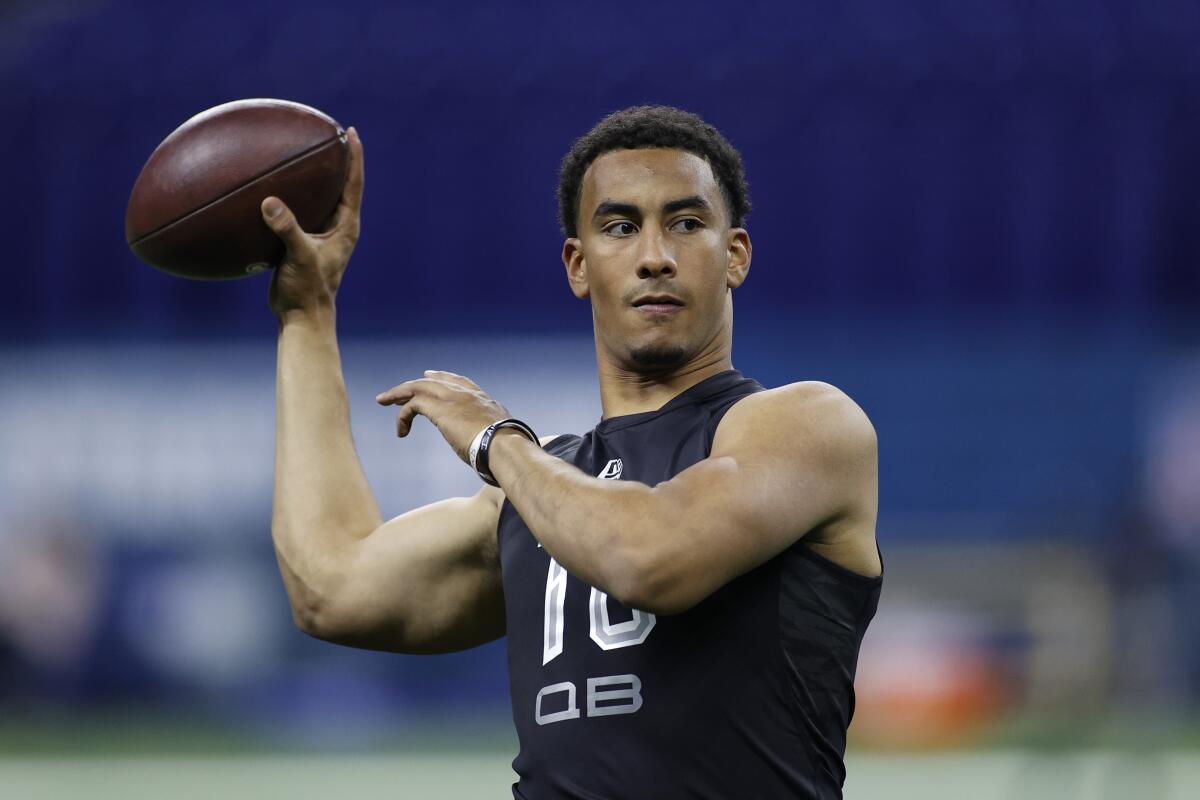
Scouts love the size, mobility and arm strength, the ability to deliver tight spirals from a variety of arm slots on the run, and believe Jordan Love can make dazzling off-schedule plays in the NFL. But they wonder if a regression from his sophomore season (3,567 yards, 32 touchdowns, six interceptions) to his junior year (3,402 yards, 20 touchdowns, FBS-high 17 interceptions) revealed weaknesses in decision-making and accuracy that will be further exposed at the next level.
The Packers traded with the Miami Dolphins to move up to No. 26. Green Bay traded its No. 30 (first round) and No. 136 picks (fourth round) to Miami, according to multiple reports.
Farmer’s take: The Packers trade up to grab a sliding quarterback. Fifteen years ago, they famously took a tumbling Aaron Rodgers with the 24th pick.
San Francisco 49ers draft Arizona State wide receiver Brandon Aiyuk at No. 25

A junior college transfer and part-time starter in 2018, Brandon Aiyuk emerged as a legitimate NFL prospect in 2019, earning third-team All-American honors after catching 65 passes for 1,192 yards (18.3 average) and eight touchdowns. He also averaged 31.9 yards on kickoff returns and 16.1 yards on punt returns. A natural pass-catcher with long arms and soft hands, Aiyuk has the size, speed and elusiveness to turn short passes into chunk plays.
The 49ers pulled off a trade with the Minnesota Vikings to obtain the No. 25 pick. They gave the Vikings their Nos. 31, 117 and 176 picks for No. 25, according to multiple reports.
Farmer’s take: The 49ers traded up to address their need at the position. The NFC champs have only two healthy wideouts on their roster.
New Orleans Saints select Michigan center Cesar Ruiz at No. 24
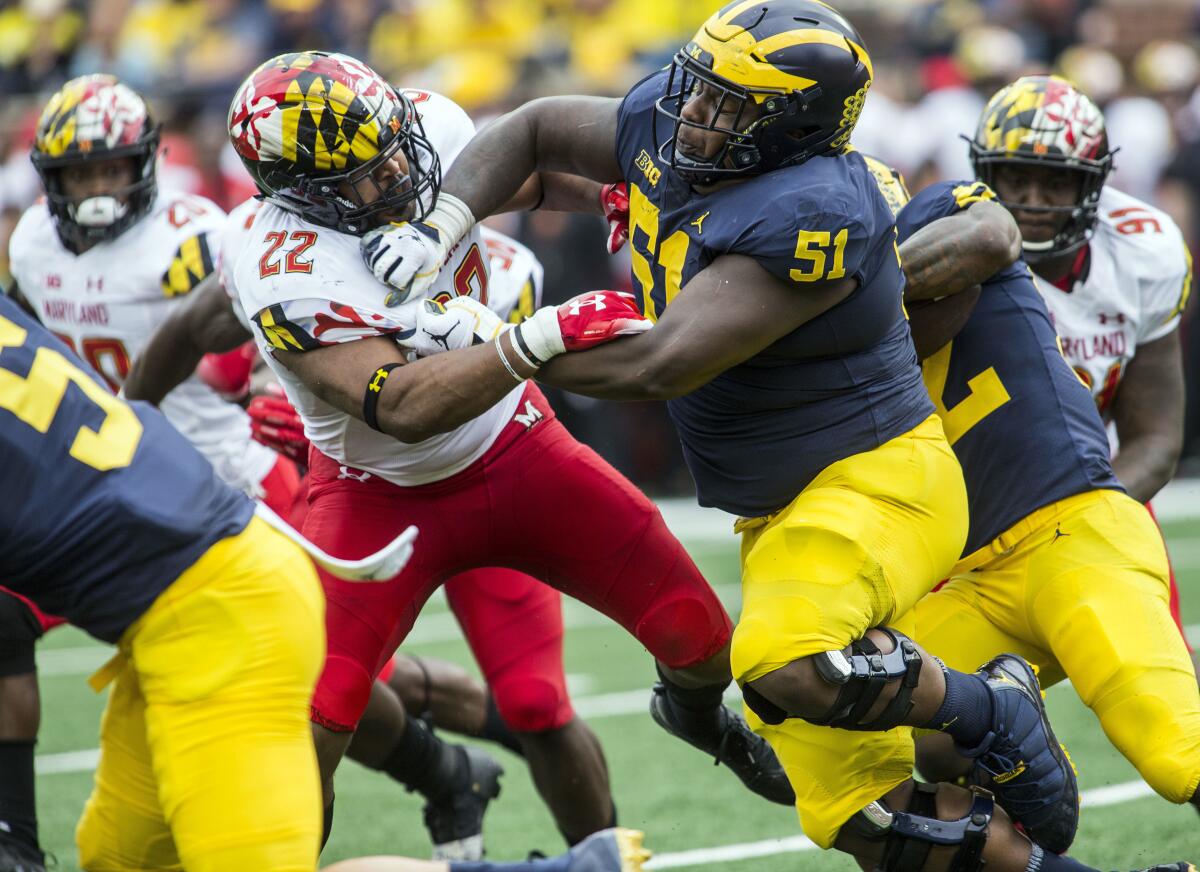
Cesar Ruiz is athletic and tenacious, with a combination of skills, technique and snap-to-step quickness that helped him become a force in the middle of the Wolverines’ offensive line for the past two seasons. Ruiz is motivated by the memory of his father, Cesar, who was hit by a car and killed on the side of a South New Jersey highway when the younger Ruiz was 8 years old. “I’m still playing for my dad,” Ruiz said. “My dad still lives through me. And that’s how it’s always going to be.”
Farmer’s take: With a 6-foot quarterback in Drew Brees, it’s essential that the Saints are solid in the interior of their offensive line. Ruiz can play center or guard.
Los Angeles Chargers draft Oklahoma linebacker Kenneth Murray Jr. at No. 23
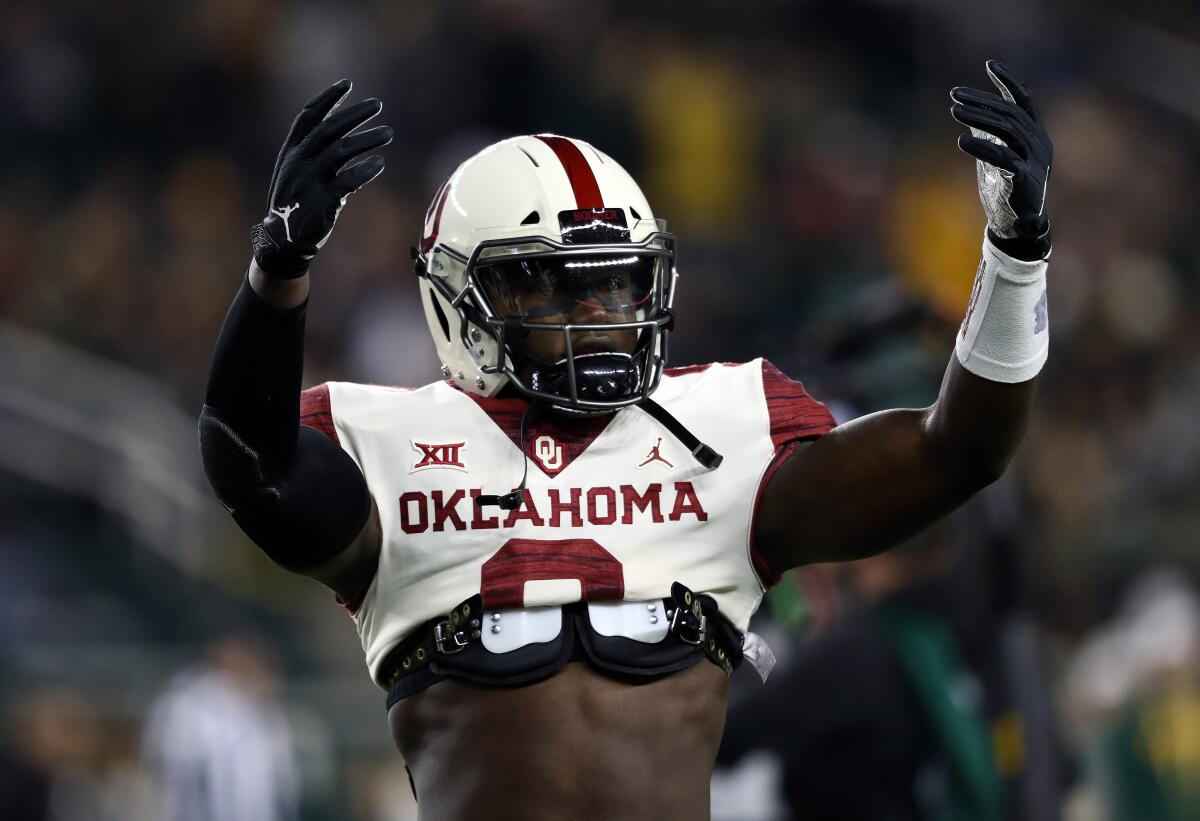
The tackling machine used his size, speed, athleticism, instincts, and tenacity to rack up 155 tackles, including a school-record 28 in an overtime win over triple-option-running Army, in 2018, and 102 tackles, 17 for loss, four sacks and four pass-breakups in 2019 for the Sooners, who went 12-2 and lost to LSU in the national semifinals. Kenneth Murray Jr. was also one of Oklahoma’s most diligent and hardest-working players, watching five or six hours of film a day.
The Chargers acquired the pick in a trade with the New England Patriots. The Chargers sent a second- and third-round pick to the Patriots for No. 23.
Farmer’s take: Murray is a tackling machine who can shore up the middle of the Chargers’ defense. He should be a great fit for Gus Bradley’s scheme.
Minnesota Vikings draft LSU wide receiver Justin Jefferson at No. 22
Once a skinny, lightly recruited high school player who ran with an awkward gait, the speedy Jefferson blossomed into a college star, catching 111 passes for 1,540 yards and 18 touchdowns to help LSU win the national title last fall. A slot receiver with super contested-catch skills and who is slippery in space, Jefferson caught 14 passes for 227 yards and four touchdowns in a semifinal win over Oklahoma and nine passes for 106 yards in a championship-game win over Clemson.
Farmer’s take: Jefferson was a slot receiver at LSU, and the Vikings already have Adam Thielen there. But with Stefon Diggs in Buffalo, this team needed to restock.
Philadelphia Eagles select TCU wide receiver Jalen Reagor at No. 21
Jalen Reagor describes himself as “a big play waiting to happen,” a testament to his blazing speed, a 42-inch vertical leap to help catch high-point passes and his versatility as a jet-sweep specialist and a return man. A three-year starter at TCU, Reagor caught 148 passes for 2,248 yards and 22 touchdowns, rushed 35 times for 324 yards and two scores, returned 23 punts for 409 yards (17.8 average) and two touchdowns and 13 kickoffs for 315 yards (24.2 average).
Farmer’s take: Philadelphia limped through with a hodgepodge of ho-hum receivers last season. Reagor isn’t big, but he’s an explosive playmaker.
Jacksonville Jaguars select LSU defensive end K’Lavon Chaisson at No. 20
After suffering a season-ending knee injury in the 2018 opener, Chaisson posted 60 tackles, 13 ½ for loss, and 6 ½ sacks for the national-champion Tigers in 2019. The speed rusher has plenty of power for his size and an ability to disrupt offenses with his lateral quickness, variety of moves and knack for finding the quarterback. One knock on Chaisson is that he is not the most physical run defender.
Farmer’s take: Chaisson had five sacks in the last four games of his college career. The Jaguars have dropped off sharply at linebacker in the past two years.
Las Vegas Raiders select Ohio State cornerback Damon Arnette at No. 19
The Raiders go with a surprise pick, selecting the Ohio State cornerback to help bolster their secondary. Arnette nearly made the jump to the NFL last year after his junior season, but his decision to stay another year paid off with a strong season that raised his draft stock. The second-team All-Big Ten selection finished with 35 tackles, an interception and eight pass breakups.
Farmer’s take: Son of Hall of Fame receiver Cris Carter, Arnette was a surprise here. The Raiders led the league last season with 15 defensive pass-interference flags.
Miami Dolphins select USC offensive tackle Austin Jackson at No. 18
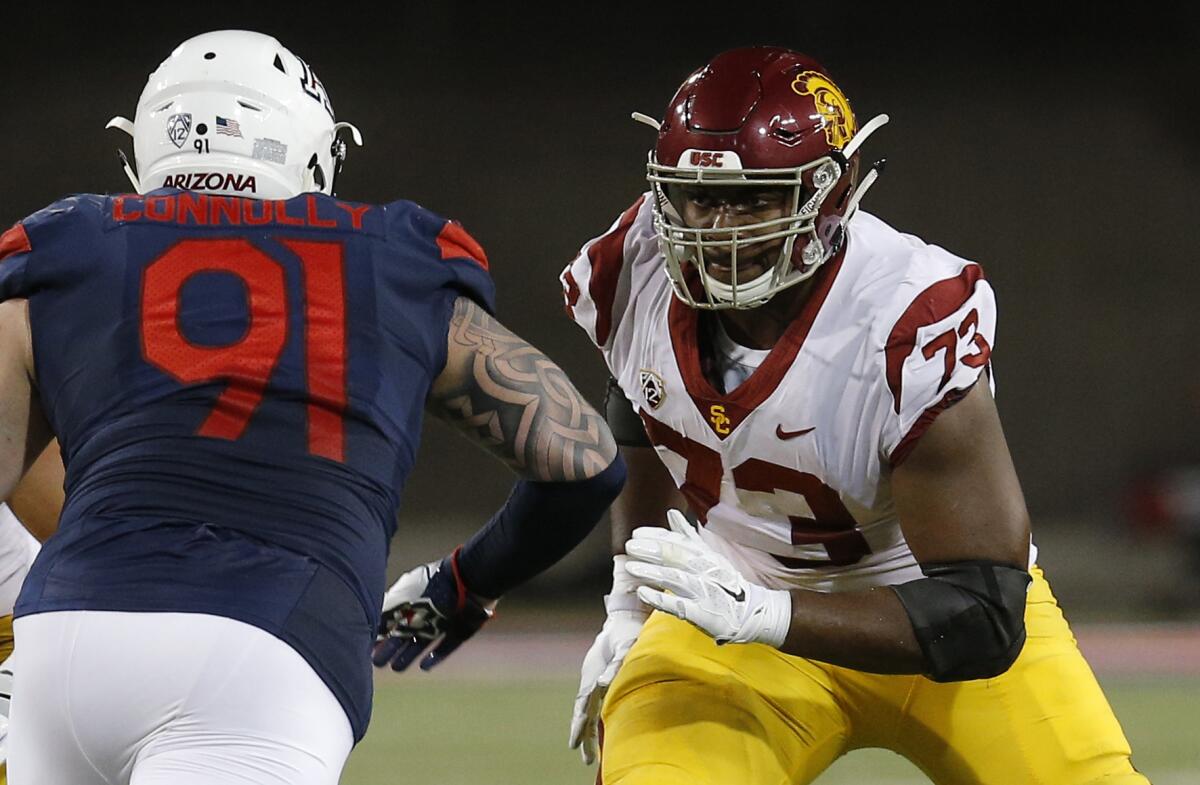
A two-year starter for the Trojans, Austin Jackson is a raw but athletic and gifted tackle with high-end NFL potential who could provide immediate help at right tackle and could also move to guard if he gains more strength. Some have questioned whether Jackson is as strong as he once was after donating bone marrow last summer to save the life of his sister, Autumn, but he recently said that he is “stronger than I’ve ever been, and I’m ready” for the NFL.
Farmer’s take: The Dolphins traded left tackle Laremy Tunsil to Houston last season, and they’re replacing him with a high-character player who’s young with big promise.
Dallas Cowboys draft Oklahoma wide receiver CeeDee Lamb at No. 17
CeeDee Lamb, a yards-after-catch machine who has been compared to NFL stars DeAndre Hopkins and Davante Adams, is the most complete receiver in a draft filled with high-end pass-catchers, with the speed and strength to overwhelm defenders and the poise and instincts to outwit them. In three college seasons — two in which he teamed with eventual No. 1 picks Baker Mayfield and Kyler Murray — Lamb caught 173 passes for 3,292 yards and 32 touchdowns.
Farmer’s take: Receiver wasn’t a top need for the Cowboys, but a mini-slide by Lamb made him too tempting. He can be a slot receiver to replace Randall Cobb.
Atlanta Falcons select Clemson cornerback A.J. Terrell at No. 16

The Atlanta native played a key role on Clemson’s 2018 national championship team, posting 54 tackles and seven pass-breakups and returning an interception 44 yards for a touchdown in the title game against Alabama. He was first-team All-ACC in 2018, when he had 37 tackles, six pass-breakups and two interceptions. Terrell has the foot agility, back-pedaling skills and patience to grind on receivers in press coverage but may lack the ball-hawking traits to be a star.
Farmer’s take: The Falcons allowed an average of 31.3 points in the first half of last season. They just couldn’t stop the pass. Team passed on an edge rusher to address the secondary.
Denver Broncos select Alabama wide receiver Jerry Jeudy at No. 15
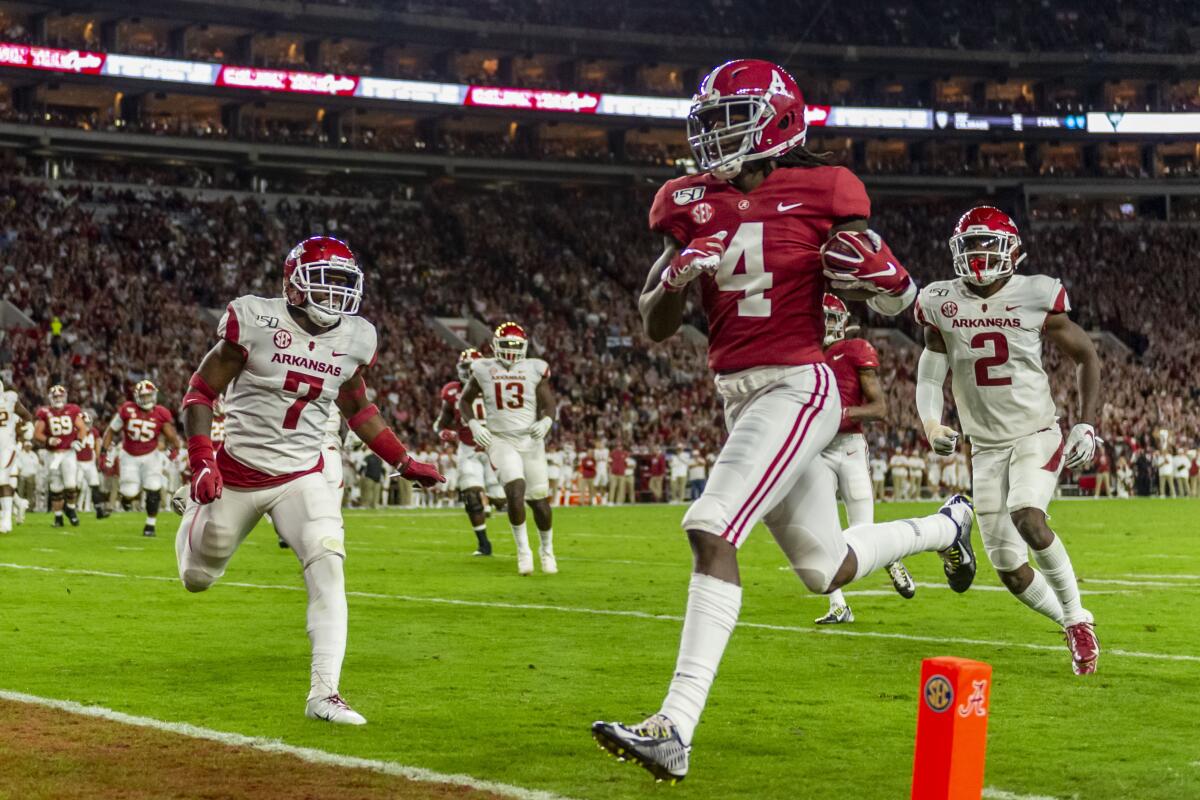
His pristine route-running and ability to separate from defenders for yards to get open and create yards after catch are among the reasons Jerry Jeudy won the Fred Biletnikoff Award as the best receiver in college football after catching 68 passes for 1,315 yards and 14 touchdowns as a sophomore in 2018. He followed that up with a strong junior season in 2019, when the Deerfield Beach, Fla., native caught 77 passes for 1,163 yards and 14 touchdowns.
Farmer’s take: The Broncos have their bookend to the outstanding Courtland Sutton. Denver needed someone to step into the cleats of Emmanuel Sanders.
San Francisco 49ers draft South Carolina defensive tackle Javon Kinlaw at No. 14
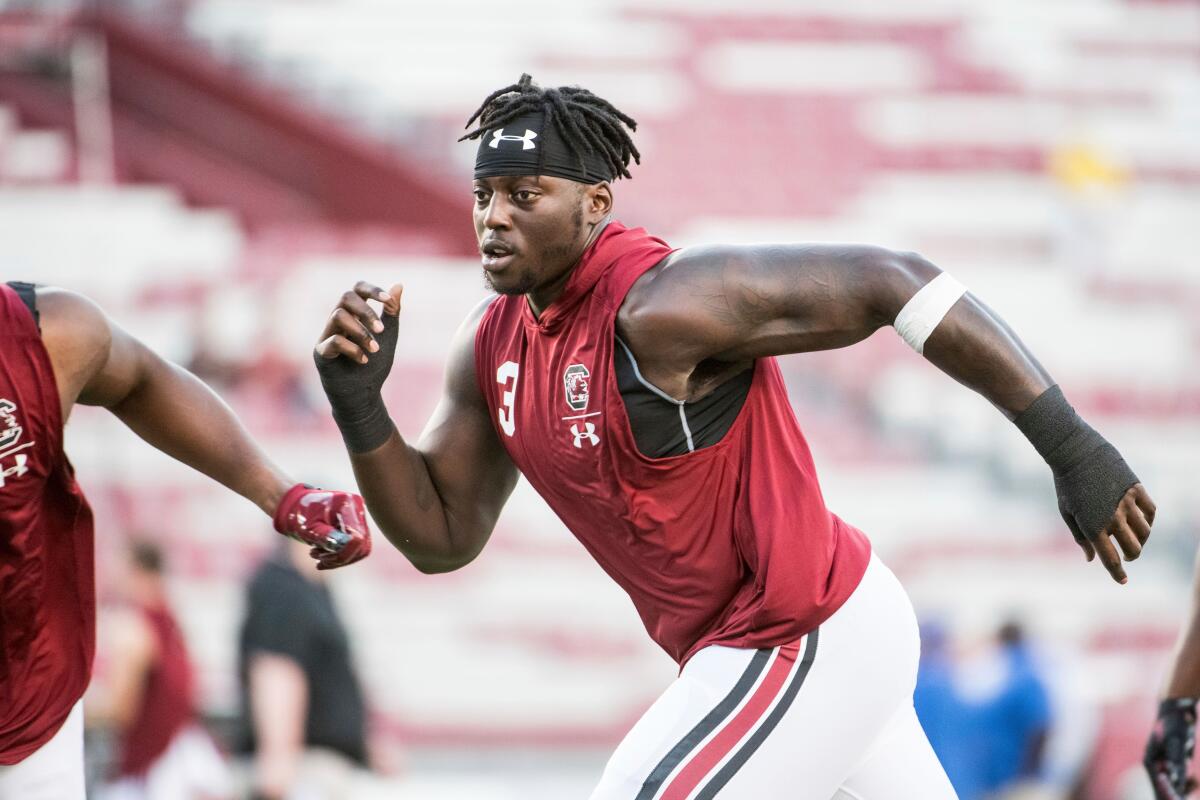
Javon Kinlaw, who was homeless for most of his childhood in Washington, D.C., didn’t start playing football until he was 15, so he was still a bit raw and inconsistent until finally reaching his potential as college senior, earning first-team All-American and All-SEC honors after posting 35 tackles and six sacks for the Gamecocks. Kinlaw has the size, length, explosive first step and power to overwhelm opponents and should improve with better moves and body control.
Farmer’s take: It all starts with the defensive line for the 49ers, and they needed to fill the vacancy left by DeForest Buckner. Wide receiver can wait.
Tampa Bay Buccaneers select Iowa offensive tackle Tristan Wirfs at No. 13
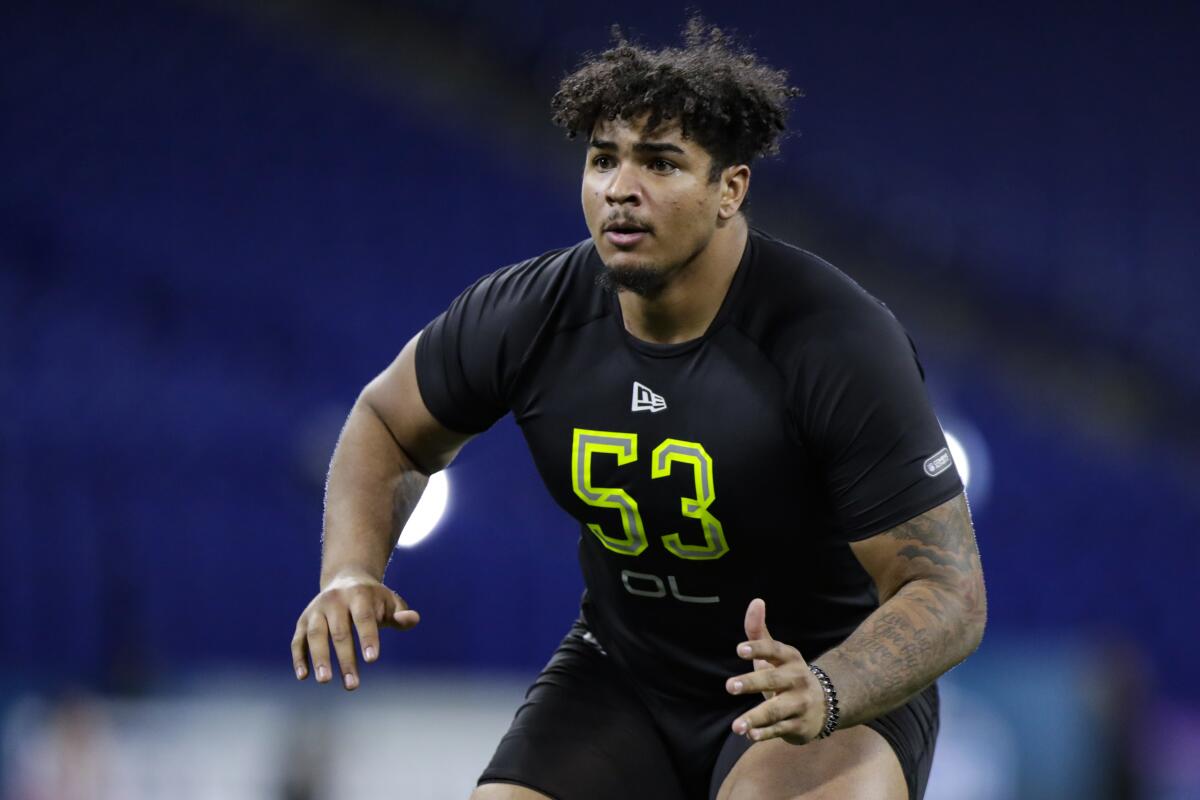
Tristan Wirfs is an explosive drive blocker who has the pulling speed to lead outside running plays and the quick feet, agility and hand strength to protect the quarterback. He improved his NFL stock at the combine, where his 10-foot-1 broad jump tied the all-time combine record for his position and his 36.5-inch vertical leap and 4.85-second 40-yard dash were the best at his spot. He also set an Iowa school record in the hang-clean lift, completing four reps at 450 pounds.
Tampa Bay made the pick after trading up from No. 14 with the San Francisco 49ers. According to multiple reports, the 49ers received the Bucs’ 14th and 117th picks. The Buccaneers also got the 49ers’ final seventh-round pick.
Farmer’s take: The Buccaneers trade up one spot to address their need at right tackle. Things are falling into place for Tom Brady.
Las Vegas Raiders select Alabama wide receiver Henry Ruggs III at No. 12

The speedy Henry Ruggs III, the son of former track star Nataki Ruggs, was part of a stellar Crimson Tide receiving corps that included Jerry Jeudy and DeVonta Smith. He averaged a team-high 18.7 yards per catch, with 40 receptions for 746 yards and seven touchdowns, while returning 12 kickoffs for 286 yards, a 23.8-yard average. Ruggs has quick, sure hands to handle off-target throws and an ability to turn quick slants and crossing routes into big gainers with his speed.
Farmer’s take: Al Davis valued speed over everything, and Ruggs checks that box. He covers 40 yards in 4.27 seconds. The Raiders’ answer to Kansas City’s Tyreek Hill.
New York Jets draft Louisville offensive tackle Mekhi Becton at No. 11

Becton clearly has the size, power and even speed — he ran a 5.1-second 40-yard dash at the combine in February — to be an impact lineman in the NFL, but his weight, quickness and stamina could be concerns. Becton, who has a 7-foot- wingspan, also had a drug test flagged at the combine, according to NFL Network, and will begin his NFL career with a 60-day probationary period in which he must pass every test for illegal substances.
Farmer’s take: The Jets didn’t do a good job of protecting Sam Darnold last season, surrendering 52 sacks. Becton is a mountain who can really move.
Cleveland Browns draft Alabama offensive tackle Jedrick Wills Jr. at No. 10
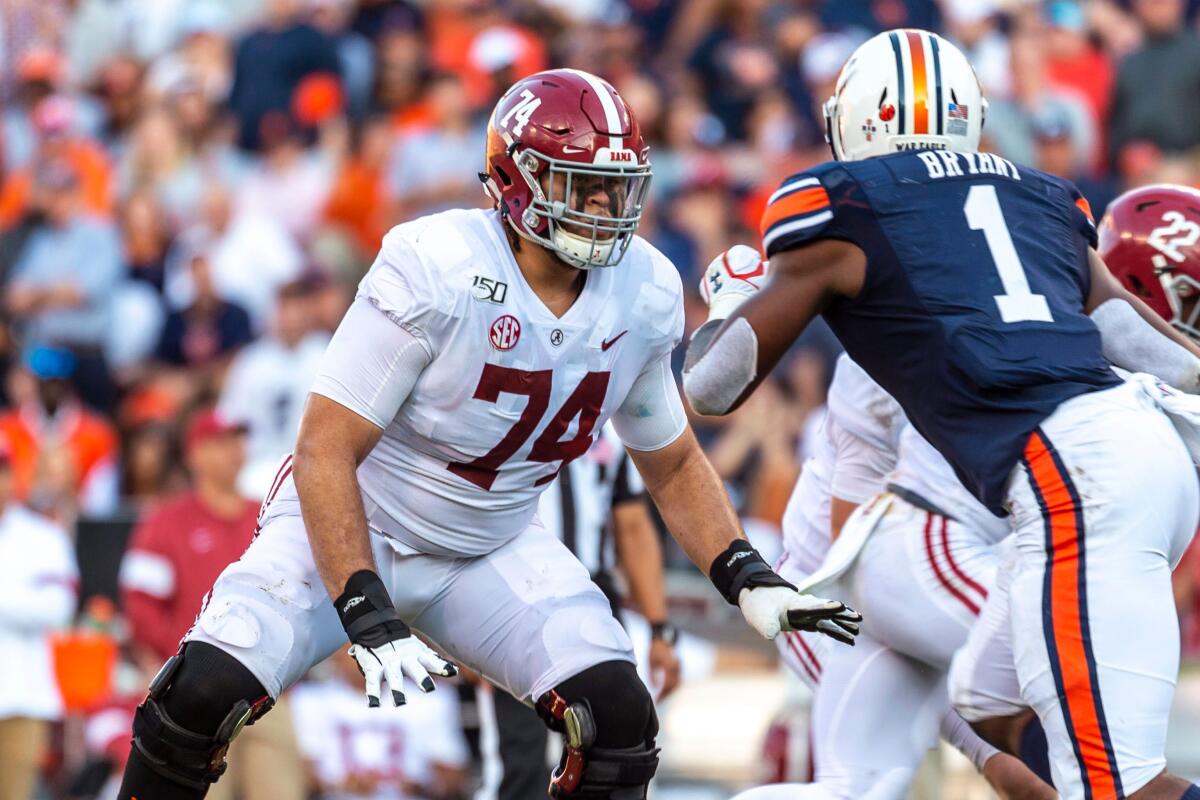
No draft analyst better captured Jedrick Wills Jr., who has a knack for blocking overmatched linemen all the way out of bounds, than NFL.com’s Lance Zierlein, who summed up the massive man-mover by saying: “He has basketball-caliber foot quickness and the quick hands of a boxer, and all of it is wrapped in a stout, powerful package of bad intentions. His game is tailor-made for the NFL, and his range of success is good starter to All-Pro.”
Farmer’s take: Wills, a true right tackle, will have to move over to the left side now that the Browns have Jack Conklin. An unquestionable upgrade from Greg Robinson.
Jacksonville Jaguars select Florida cornerback CJ Henderson at No. 9
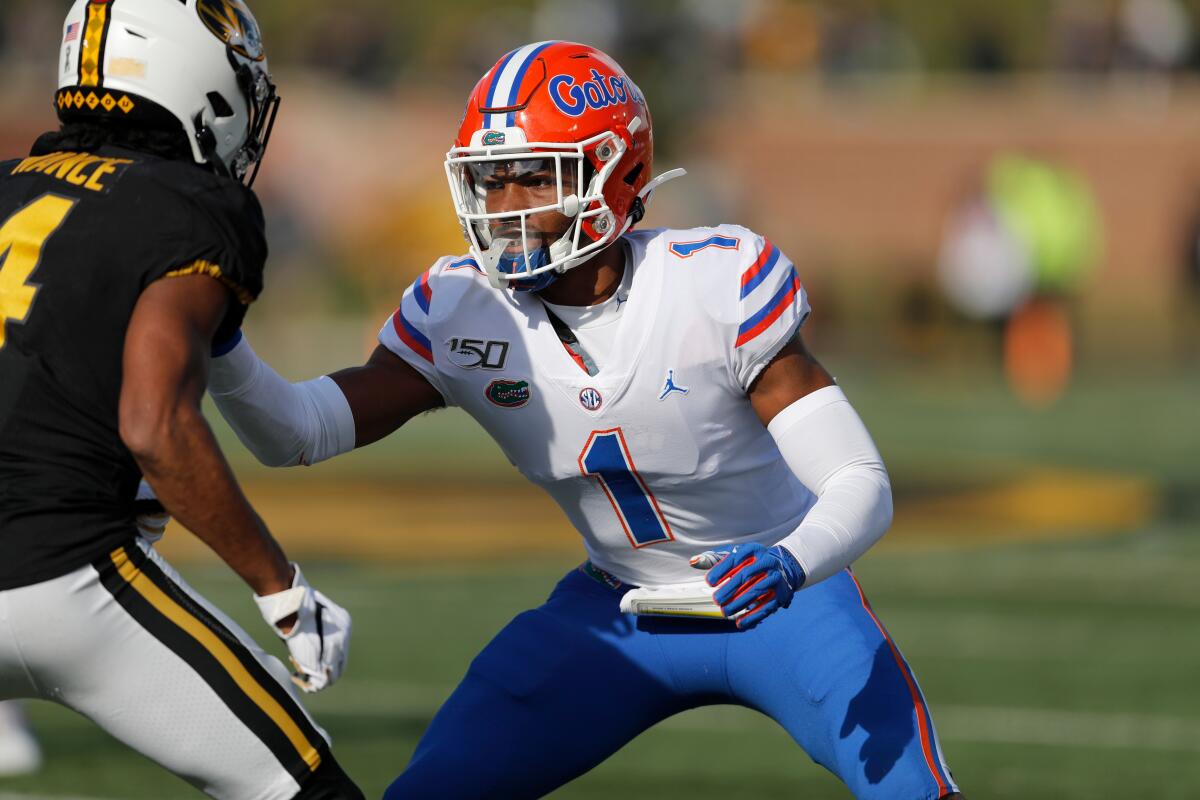
A three-year starter in college, Henderson had a team-leading 11 pass-breakups to go with 33 tackles, three for loss, despite playing in just nine regular-season games because of an ankle injury. The Miami native has the speed — he ran a 4.39-second 40-yard dash at the NFL combine — footwork, agility and athleticism to stick with receivers and the twitchy acceleration to jump a route and pick off a pass if the opportunity arises. He should improve as an open-field tackler.
Farmer’s take: With Jalen Ramsey and A.J. Bouye gone, the Jaguars needed to restock the shelves at cornerback. Henderson is smothering in man coverage.
Arizona Cardinals select Clemson linebacker Isaiah Simmons at No. 8
Isaiah Simmons is the consensus top linebacker in the draft, but his impressive blend of size, strength, speed and agility allowed him to play edge rusher, cornerback and safety in college. Labeled the most ready NFL prospect to contribute to his new team, Simmons led the Tigers with 107 tackles, 16 for loss, and eight sacks in 2019. He also made a pivotal interception in a College Football Playoff semifinal victory over Ohio State.
Farmer’s take: Cardinals needed a right tackle, but adjust when Simmons tumbles out of top five. With Simmons and Chandler Jones, Cardinals have a pass rush.
Carolina Panthers select Auburn defensive tackle Derrick Brown at No. 7
The Sugar Hill, Ga., native could have entered the draft as a junior after showing flashes of his NFL potential, but when he heard questions about his consistency, Brown returned for his senior season to improve his draft stock. With the size, strength and athleticism to be a disruptive force on the line, Brown posted 55 tackles, 12 ½ for loss, four sacks, four pass breakups and two force fumbles to earn first-team All-American honors in 2019.
Farmer’s take: The NFL’s worst run defense gets a wrecking ball in the middle. The Panthers needed someone to get after Tom Brady, Matt Ryan and Drew Brees.
Los Angeles Chargers select Oregon quarterback Justin Herbert at No. 6
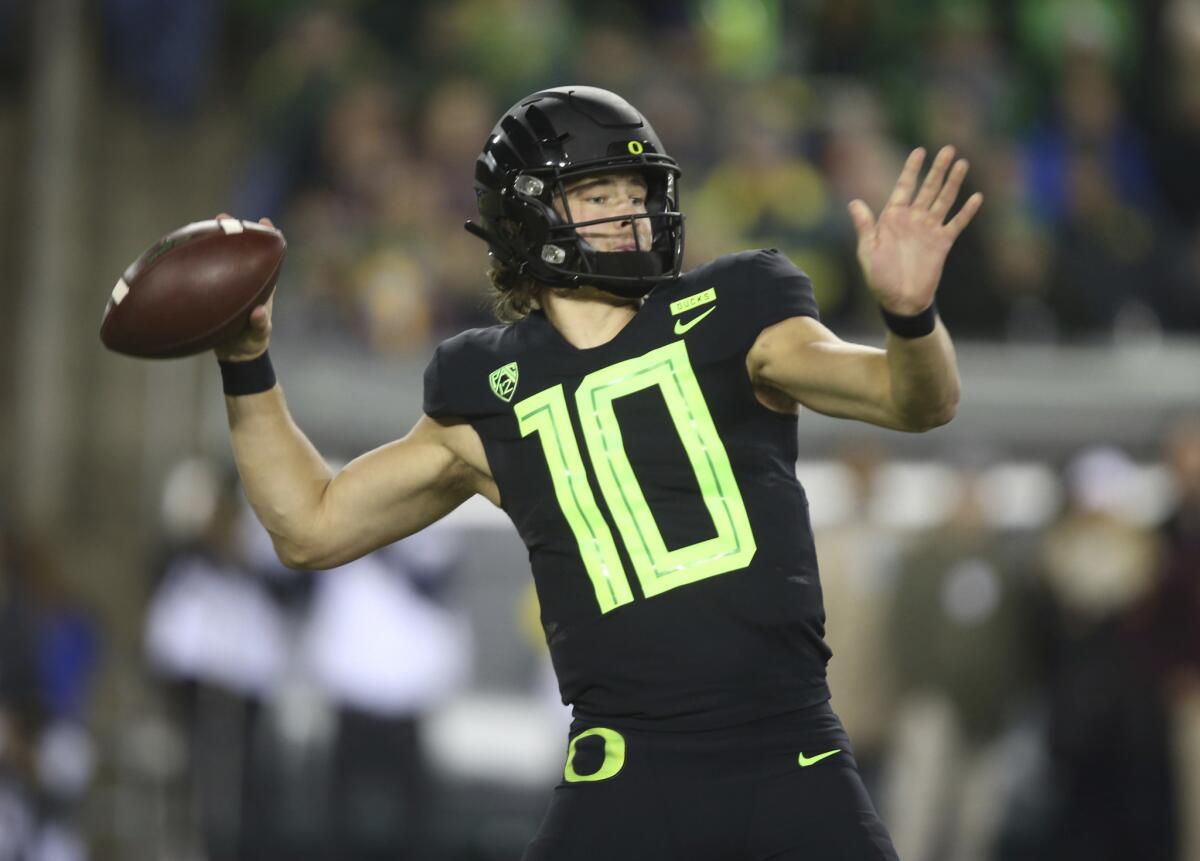
One of few seniors at the top of the draft, Herbert has the physical tools to be an impact player in the NFL—superior size and field vision, a cannon for an arm, the intelligence and experience to go through his progressions without panicking and the mobility to extend plays with his legs. He completed 286 of 428 passes for 3,471 yards, 32 touchdowns and six interceptions to lead the Ducks to a 12-2 record and a Rose Bowl win over Wisconsin.
Farmer’s take: The eventual Philip Rivers replacement has been compared to Buffalo’s Josh Allen. Strong arm and a fearless runner. Is he a quick decision-maker?
WATCH: What The All 32 says about Justin Herbert
Miami Dolphins select Alabama quarterback Tua Tagovailoa at No. 5
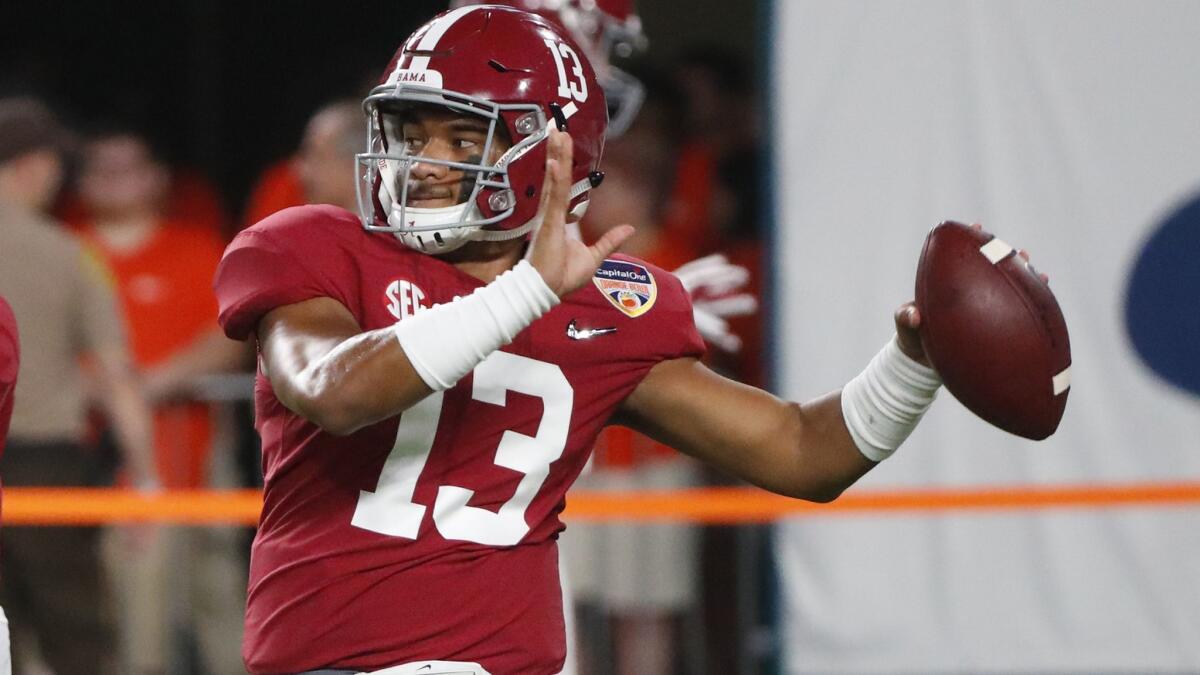
The dual-threat left-hander, who led the Crimson Tide to the 2017 national title and the 2019 national championship game, has the speed, agility, arm talent, accuracy and touch to create chunk plays through the air and on the ground, but a season-ending surgery to repair a hip dislocation last November has clouded his future as a pro. In three college seasons, Tagovailoa completed 474 of 684 passes (69.3%) for 7,442 yards, 87 touchdowns and 11 interceptions.
Farmer’s take: The Dolphins have had 21 starting quarterbacks since Dan Marino, and Tagovailoa is the second they’ve taken in the first round since (Ryan Tannehill).
New York Giants select Georgia offensive tackle Andrew Thomas at No. 4
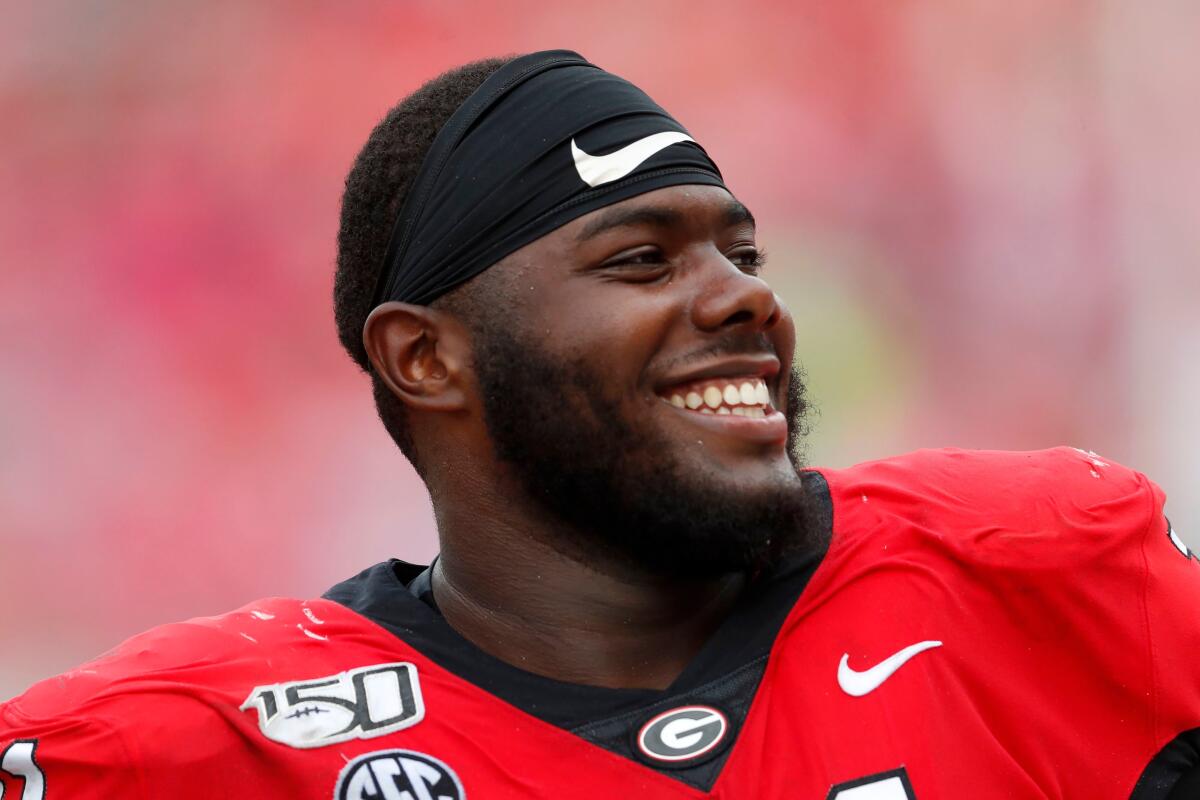
Thomas went from his high school team at Atlanta’s Pace Academy in 2016 into Georgia’s starting lineup the following year, and after earning freshman All-American honors as a right tackle in 2017 he earned first-team All-American honors as a left tackle in 2019. Thomas is fiercely competitive and has huge, powerful hands but scouts believe he needs to clean up a few technical issues in his pass-protecting sets.
Farmer’s take: Thomas can play left or right tackle, is strong in pass protection, and the Giants need someone to push open holes for Saquon Barkley.
Detroit Lions pick Ohio State cornerback Jeff Okudah at No. 3
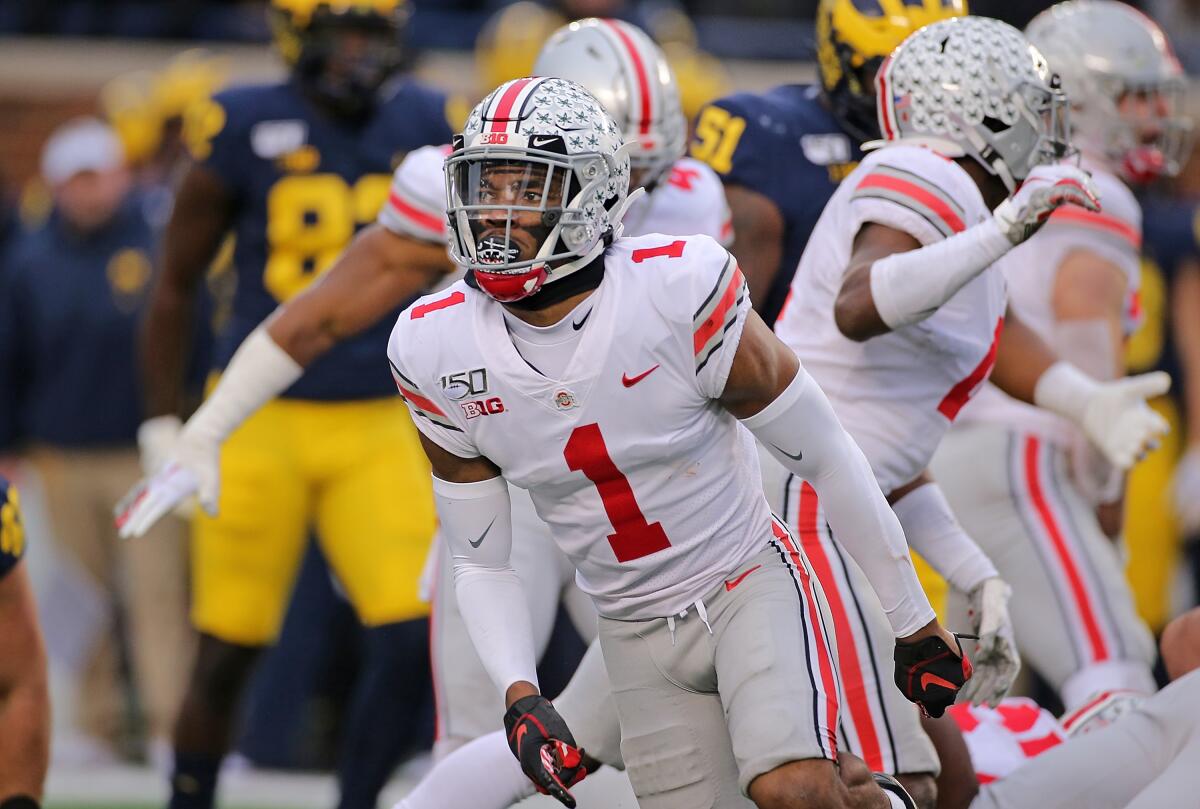
The 11th Buckeyes cornerback to be picked in the first round, Okudah has the size, length, foot quickness and technique to stick with NFL wideouts in press coverage and the elite burst and speed to close them down in space. Scouts believe he has the mental makeup and character to match his physical traits. Okudah led Ohio State with three interceptions and nine pass breakups and had 35 tackles and two forced fumbles while earning first-team All-American honors in 2019.
Farmer’s take: With Darius Slay now in Philadelphia, the Lions grabbed a physical, press corner – and, considering Burrow started at OSU, the third straight Buckeye.
Washington Redskins pick Ohio State defensive end Chase Young at No. 2
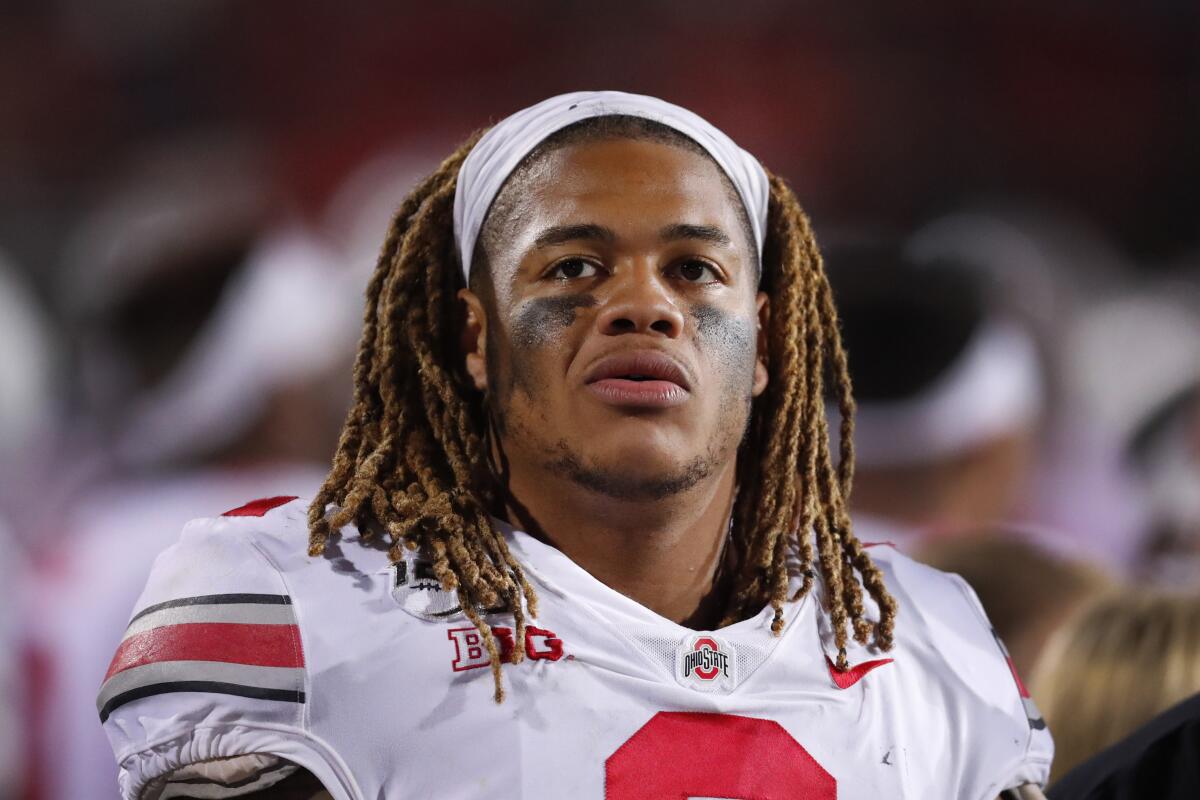
With his elite size, strength, athleticism and strength, Young led the nation with 16 ½ sacks in 12 games in 2019, four coming in a win over Wisconsin after which Buckeyes coach Ryan Day called Young “the most dominant player in all of college football.” Young, who also tied for fourth in the nation with 21 tackles for loss, won the Chuck Bednarik, Ted Hendricks and Bronko Nagurski awards as the top defender or lineman in the country.
Farmer’s take: Between them, Ron Rivera and Jack Del Rio coached Von Miller, Julius Peppers and Khalil Mack. That’s a high bar for Young.
Cincinnati Bengals select LSU quarterback Joe Burrow with first pick of 2020 NFL draft
Although he lost the competition for the starting job at Ohio State, Burrow transferred to LSU and wound up winning the Heisman Trophy in 2019. He completed 402 of 527 passes (76.3%) for 5,671 yards and threw 10 times as many touchdown passes (60) as interceptions (six) to lead the Tigers to a 15-0 record and the national championship. He’s widely regarded as the best quarterback prospect in this class.
Sam Farmer’s take: For third straight year, the Heisman winner goes No. 1. Burrow is headed to a franchise without a playoff victory since the 1990 season.
Iowa’s Tristan Wirfs looks to pay back his mother’s sacrifices with NFL success
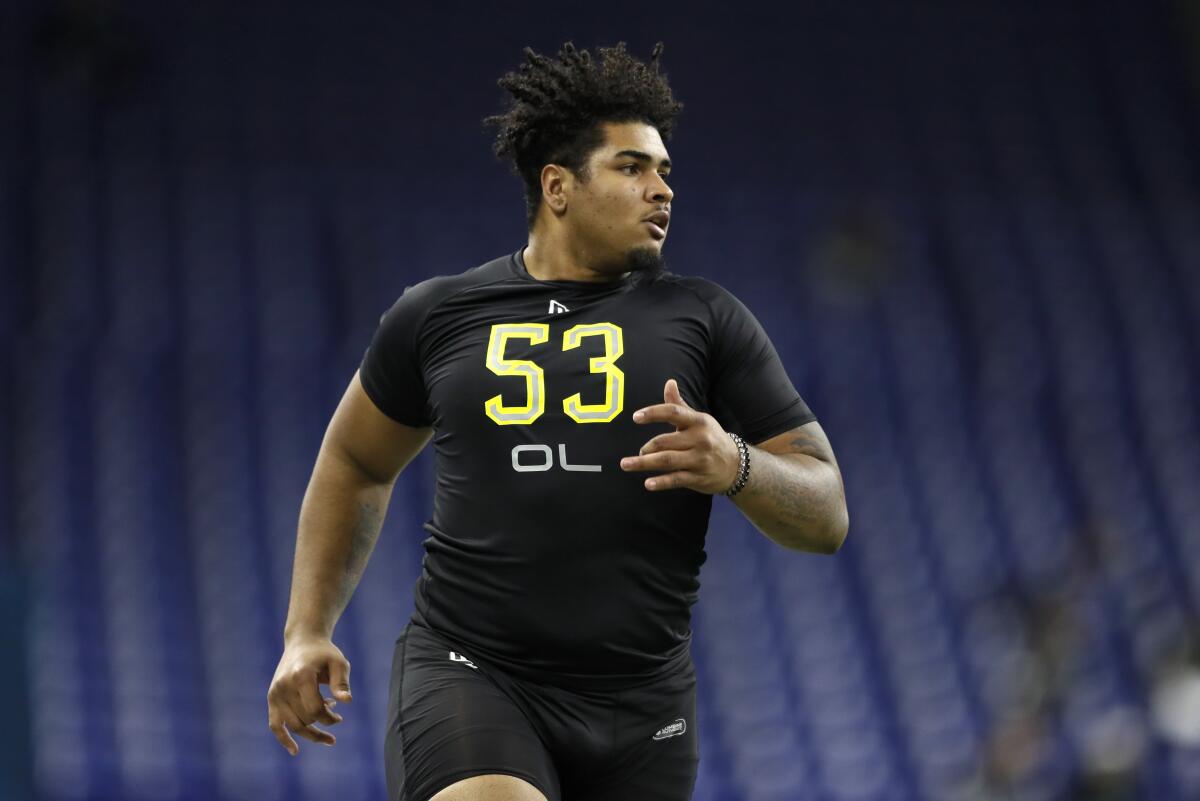
Tristan Wirfs spent the first five years of his life living in a trailer park in tiny Mt. Vernon, Iowa, with his mother, grandmother and eventually a younger sister.
The family moved into a house by the time Wirfs started kindergarten, but keeping Tristan fed — no small task for a boy who grew into a 6-foot-5, 320-pound mountain of a man — and equipped for sports was a challenge for his single mother, Sarah, who has worked at a Target store for the last 28 years.
“I’d see her on the phone with her sister and she’d be crying about stuff — bills, the new baseball bat, glove and cleats she’d have to buy,” Wirfs, the Big Ten offensive lineman of the year at Iowa in 2019, said at the recent NFL combine.
For Oklahoma’s Neville Gallimore, myth becomes reality with NFL dream
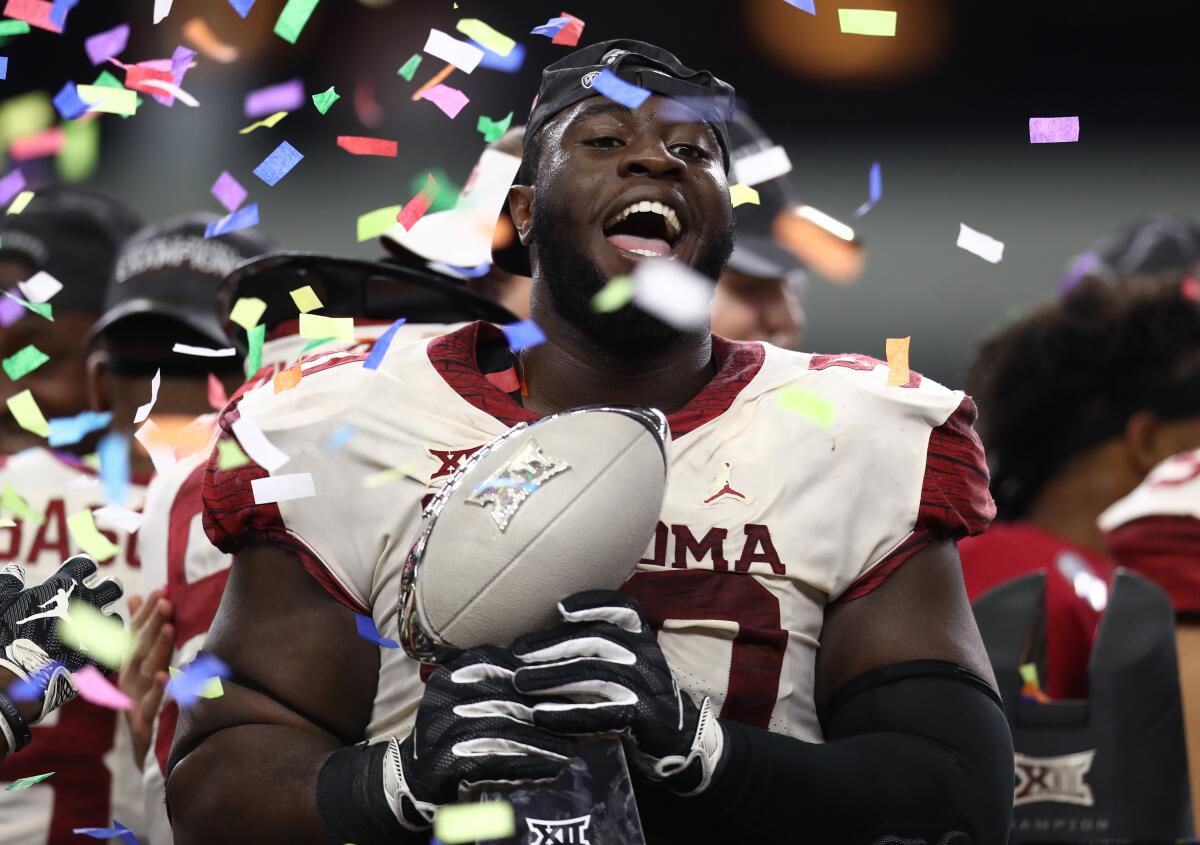
The hulking, 300-pounder crouched into a stance and dug three fingers into the turf. Neville Gallimore never actually expected to make it to this point. The son of Jamaican farmers, who grew up in Canada, his love of football arrived by accident at age 11. But now, here he was, on the cusp of the NFL, readying for a 40-yard dash, prepared to show the football world he belonged.
“If you had told me this six or seven years ago,” Gallimore said, “I’d have said you were crazy.”
Indeed, he’d taken a stranger path than most to the NFL scouting combine. In a country where consistent four-down football is rare at the high school level, the Ottawa native wound up at Canada Prep Academy, 20 minutes from the border, in hopes of catching the attention of American college football programs. It didn’t take long, with 30 schools offering scholarships.
Patrick Queen, a late bloomer for LSU, could go early in the NFL draft

When Devin White left Louisiana State to be drafted No. 5 overall by the Tampa Bay Buccaneers last offseason, Patrick Queen figured it was his time to shine as the Tigers’ featured inside linebacker.
He’d been dreaming of that opportunity for many years, having grown up in the small town of Ventress, La., just up the Mississippi River from Baton Rouge.
But, to start the 2019 season, LSU coach Ed Orgeron told the junior Queen he’d have to wait some more.
“Going into camp, we were competing for a spot. Didn’t win it,” Queen said.
Georgia’s Andrew Thomas finds the right beat when it comes to his NFL pursuits

Andrew Thomas’ high school football coach saw a fabulous hunk of clay in his freshman offensive tackle. Chris Slade of Atlanta’s Pace Academy also noticed that he was having trouble putting his imprint on the young player, who simply seemed distracted by other pursuits.
Thomas had grown up playing the drums in his church band, just like his father, Andre. And once Thomas got to Pace, he naturally joined the school’s drum line.
“I’d be at the pep rally, and I’d be playing in the band with my jersey on and then I’d go over to the football team and do the football things,” Thomas recalled.
At football practice, Thomas was just as likely to be mimicking drum beats with his hands as using them to shift an opposing defensive lineman.
The tape, he admits, was ‘bad.’ So Mekhi Becton took a deep look into his soul

Mekhi Becton weighs 350-plus pounds, stands 6 feet 7 inches, has a 7-foot wingspan and somehow can peel off a 5.1-second 40-yard dash.
None of that makes much sense until you learn a little about his parents.
Father Jerome Becton was a semi-pro and Arena Football League defensive tackle who is now a transportation supervisor, so he knows something about efficient movement. But mother Semone’s career may bring the best explanation for the combination of attributes that have Mekhi atop many offensive tackle draft boards.
LSU’s Clyde Edwards-Helaire eager to complement an NFL run attack

Clyde Edwards-Helaire’s favorite Louisiana seafood boil calls for 35 to 40 pounds of live crawfish, cleaned, in addition to two pounds of shell-on shrimp and one pound of smoked sausage cut into small pieces.
There’s no debating the featured attraction in this steaming pot of Cajun scrumptiousness.
“Crawfish all day,” Edwards-Helaire said at the recent NFL combine in Indianapolis.
As a small but speedy running back out of Louisiana State, Edwards-Helaire was more like an accompaniment, one of those mini corn on the cobs, on a delectable Tigers offense that included Heisman Trophy-winning quarterback Joe Burrows and geaux-to receivers Justin Jefferson, Ja’Marr Chase and Terrace Marshall Jr.
Wisconsin running back Jonathan Taylor has answers for NFL draft questions
Perhaps nobody arrived at the NFL combine in February having accomplished more while answering fewer questions for scouts than Jonathan Taylor.
Sure, he broke Herschel Walker’s three-year rushing record with 6,174 yards at Wisconsin … but what about those 18 fumbles?
Yeah, his durability is a known commodity … but what about his lack of sustained pass-catching out of the backfield?
Yep, he seems like he might make a really good pro running back … but what about all those other enticing prospects who might be more complete players?
Ross Blacklock just couldn’t follow in his father’s Globetrotters footsteps
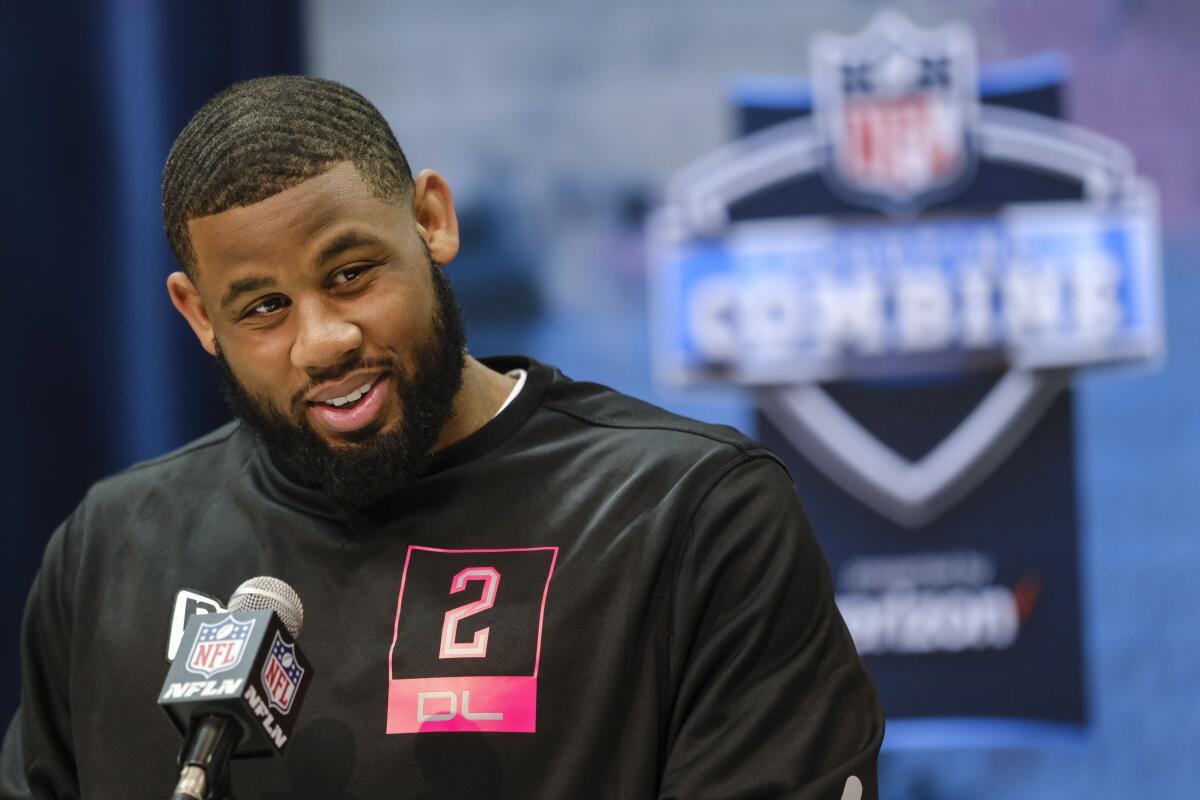
Jimmy Blacklock was a trailblazer and a Globetrotter, the second African American to play basketball at the University of Texas in the early 1970s and a standout point guard and dazzling dribbler for Harlem’s barnstorming basketball team from 1974 to 1987.
His son, Ross Blacklock, a Texas Christian defensive tackle who is expected to be a late first-round pick in the NFL draft, played some hoops in high school in Missouri City, Texas, but he never desired to follow in the footsteps of his acclaimed father.
“I always used to foul out of basketball games,” Blacklock, a 6-foot-3, 290-pound junior, said at the NFL combine in February. “I’d come off football season and go straight to basketball. Sometimes I’d be too aggressive, and I was like, ‘Dang, this is just too soft for me.’
“It’s a good sport, and I’m glad I got into it, but I just like the physicality of football, the hitting, the strength, the power, everything you have to put into it. You’ve got to be tough.”
Hands down, Penn State receiver K.J. Hamler has speed that catches NFL draft eyes
His speed had never been in question. But when it came to quantifying exactly how fast he was on a football field for teams differentiating their NFL draft boards by mere milliseconds, K.J. Hamler knew he had a problem.
The speedy, 5-foot-9 receiver didn’t run a 40 at the NFL scouting combine, having suffered a hamstring injury while training. He didn’t run at Pro Day, either, as the COVID-19 pandemic led Penn State and countless others to cancel. So with no other way to reliably quantify his most marketable skill, Hamler turned to technology.
Javon Kinlaw’s journey from homelessness to success

Javon Kinlaw didn’t attend junior college so that he could become one of the most feared defensive linemen in the Southeastern Conference or go on to the NFL.
He just wanted a place to stay and enough to eat.
“Just having three meals,” Kinlaw said of his motivation at the NFL combine in Indianapolis.
Such basic necessities were never a given growing up. Kinlaw was homeless for most of his childhood in Washington, D.C., sometimes staying in a cramped basement with his brother and mother. There was no electricity or water, so the family would have to boil water from a neighbor’s garden hose to take a shower.
Despite criticism ahead of draft, LSU safety Grant Delpit says he can tackle NFL
No set of pads can conceal the sizeable chip on the shoulder of Louisiana State safety Grant Delpit, who won the Jim Thorpe Award as the top defensive back in college football last season despite tackling inconsistencies that plagued him throughout his college career.
“I get a lot of hate and slander from the media and the experts,” the 6-foot-2, 213-pound Delpit said at the NFL combine. “I think that’s just going to make the glory so much better in the end.
“They say tackling is definitely the thing I have to improve on. It’s all about the approach and not trying to do too much, just get them on the ground. I know I can do it. I’ve been doing it my whole life.”
Florida’s CJ Henderson sees himself as the top corner in the NFL draft

CJ Henderson’s football journey has taken him five hours up the Florida Turnpike, from Miami Columbus High to Gainesville for three years as a standout cornerback with the Florida Gators.
His next stop could be considerably closer.
The Jacksonville Jaguars, just an hour away, hold the ninth pick in the NFL draft and need a starting cornerback to play across the field from Tre Herndon. Practically a local, Henderson makes a lot of sense in that spot even for those who don’t overtly favor hometown prospects.
Tua Tagovailoa and Justin Herbert are NFL saviors — or are they?
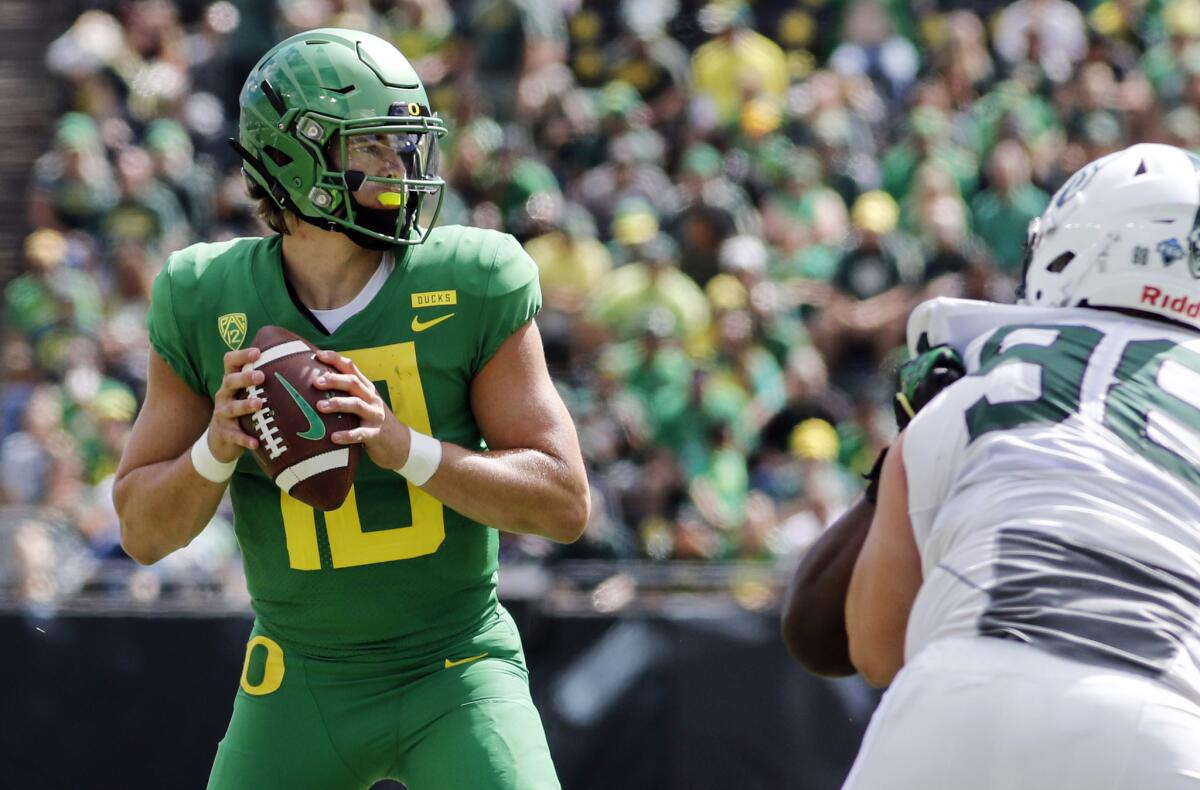
Et Tua, Justin?
For all their widespread appeal, all their unmatched gifts, all their potential to lead a downtrodden NFL franchise back to glory, quarterbacks Tua Tagovailoa and Justin Herbert have generated a lot of questions.
How much of a concern is Tagovailoa’s hip recovery? Will he even be able to make it through a full season given an injury history at Alabama that also includes wrist and ankle issues?
Can Herbert make the transition from a no-huddle offense at Oregon heavily reliant on the shotgun formation to one that’s more traditionally used in the NFL? Can he show a little more precision on short and medium routes?
Those are the primary issues that have led Tagovailoa and Herbert to being slotted behind Joe Burrow in most projections ahead of the draft that starts Thursday.
Jalen Reagor’s swift ascent is slowed down
Two wide receivers showed up to the NFL scouting combine with the expectation of running the fastest 40-yard dash. Jalen Reagor of Texas Christian was unafraid to be bold before the clock would tell the tale between him and Henry Ruggs III of Alabama.
“He runs after me. I’m going to set the bar for him,” Reagor said.
Reagor arrived at the combine 11 pounds heavier than his playing weight of 195 at TCU, hoping to show teams that he could still be an electric playmaker with added size.
His hope was to run a time in the high-4.2 to low-4.3 range but came up way short at 4.47 seconds.
Georgia RB D’Andre Swift hopes NFL teams see his potential
He is the latest in a line of star-studded Georgia backs bound for the NFL, following in the formidable footsteps of Todd Gurley, Nick Chubb and Sony Michel, but ask D’Andre Swift to compare his destined path to another back, and he’ll veer outside of Athens.
“I’d say Christian McCaffrey,” Swift said in a video tweeted by the NFL.
At a position steadily declining in value, it’s a potentially valuable comparison ahead of the draft. Fresh off a season in which he became just the third player in NFL history to have 1,000 yards rushing and receiving, McCaffrey signed the largest contract for a running back in league history last week.
TCU’s Jeff Gladney hopes to bring some prime-time swagger to the NFL

Jeff Gladney’s father used to call him “Little Prime,” a playful twist on the nickname “Prime Time” that has long been held by famed cornerback Deion Sanders.
It fits for someone who possesses Hall of Fame-level swagger on the eve of his ascent from Texas Christian to the NFL.
Consider Gladney’s mentality when he was asked at the NFL combine about being in press coverage: “You’ve just got to line up across a dude, the dude across from you, just know you’re going to beat him every play.”
If Chargers don’t pick quarterback in NFL draft, tackle or dominant defender likely
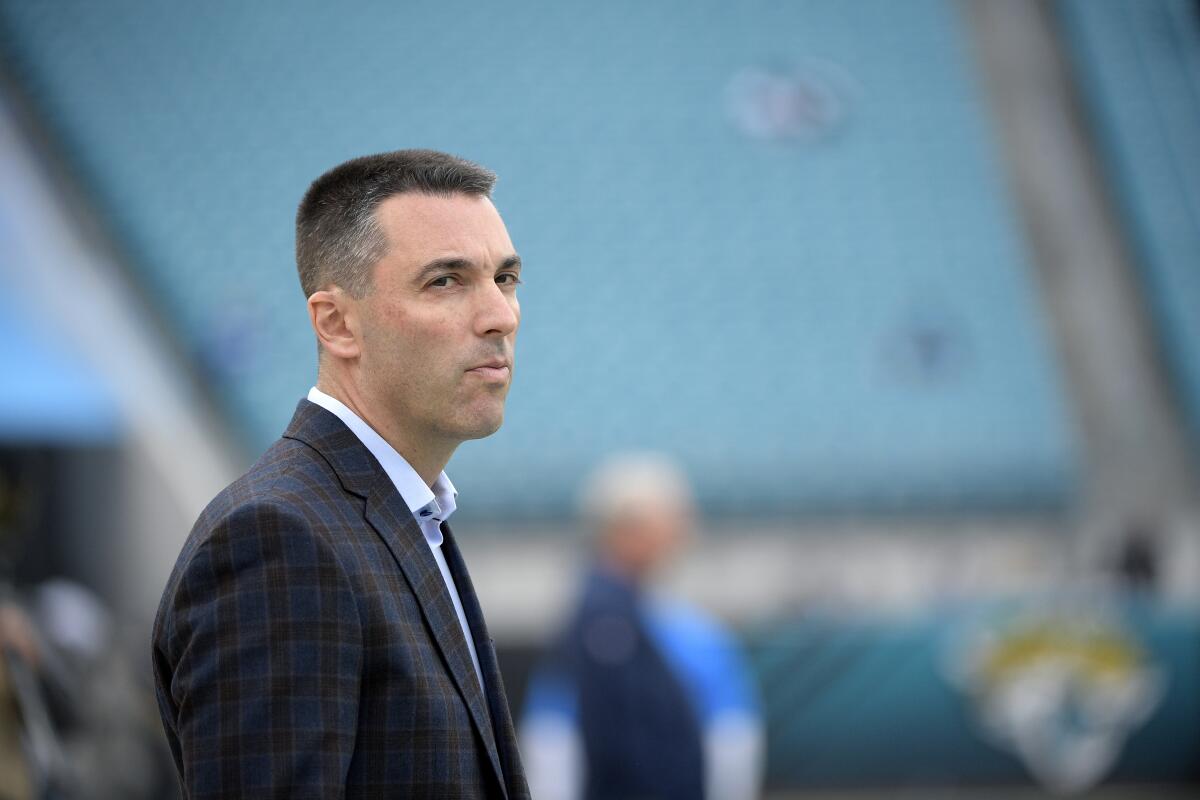
They are, by the very definition of the phrase, the ultimate “Charger insiders.”
Tom Telesco’s wife, Larah, and the couple’s three kids — daughter Elena and sons Thomas and Nicholas — have shared the same space during his most recent preparation for the 2020 NFL draft.
COVID-19 pandemic restrictions have forced Telesco — as with every other general manager in the league — to work at home over the past several weeks.
Yet, with the draft set to begin at 5 p.m. PDT Thursday, Telesco insisted that not even those closest to him — literally, in these days of social distancing — know what he’s scheming.
Alabama, LSU go for record-tying ‘pick six’ in NFL draft
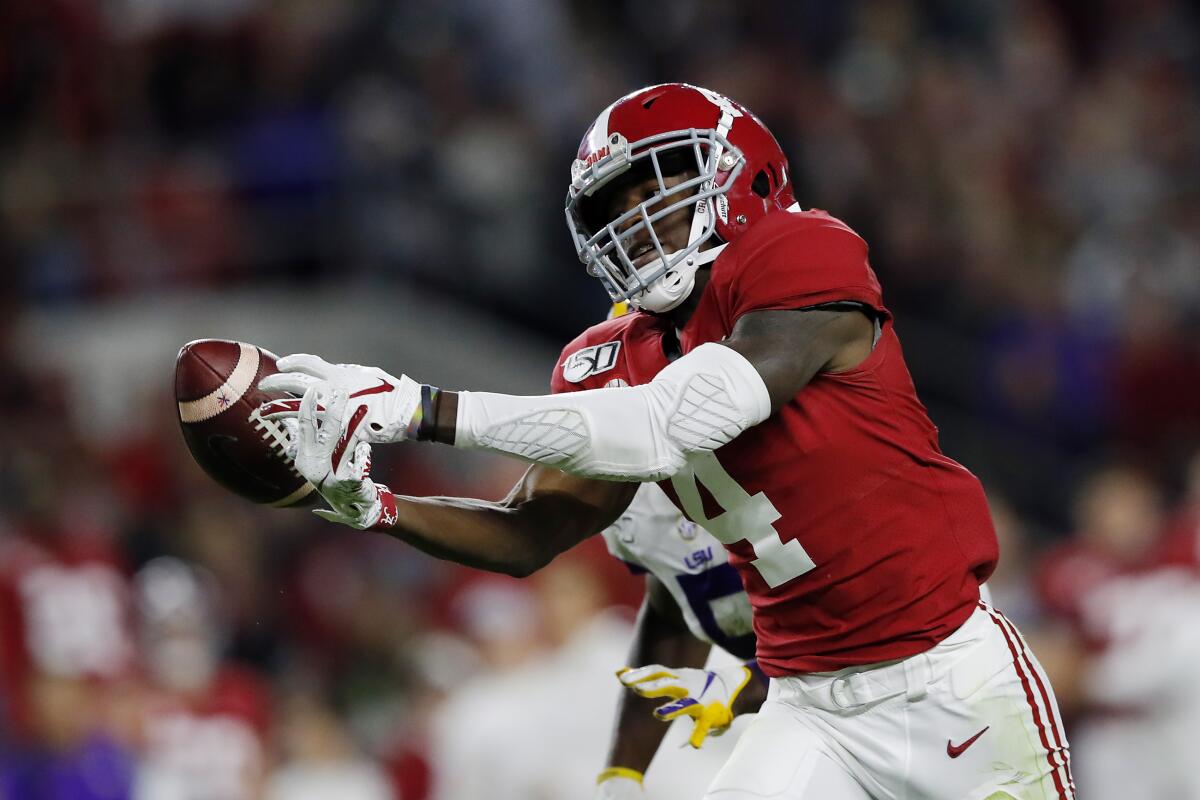
Nobody knows when Southeastern Conference football rivals Alabama and Louisiana State will play against each other again. It might be Nov. 7 in Tiger Stadium as scheduled. It might not.
In the age of the novel coronavirus, it is better to focus on what little we actually know is coming. Thursday night’s NFL draft is taking on a greater importance on a societal level than it has before simply because it’s the only major sports event that has not been canceled or postponed since March 12.
Luckily for college football fans — particularly those who proudly accentuate their game-day gear with houndstooth or a well-placed tiger tail — the draft night stakes will be inflated too.
Take a look at the Los Angeles Times’ All 32 NFL mock draft. The beat writers assembled by the Times’ Sam Farmer from across the league set up quite a battle between Alabama and LSU.
Pick Tua Tagovailoa! He could be the bolt of lightning Chargers need in L.A.
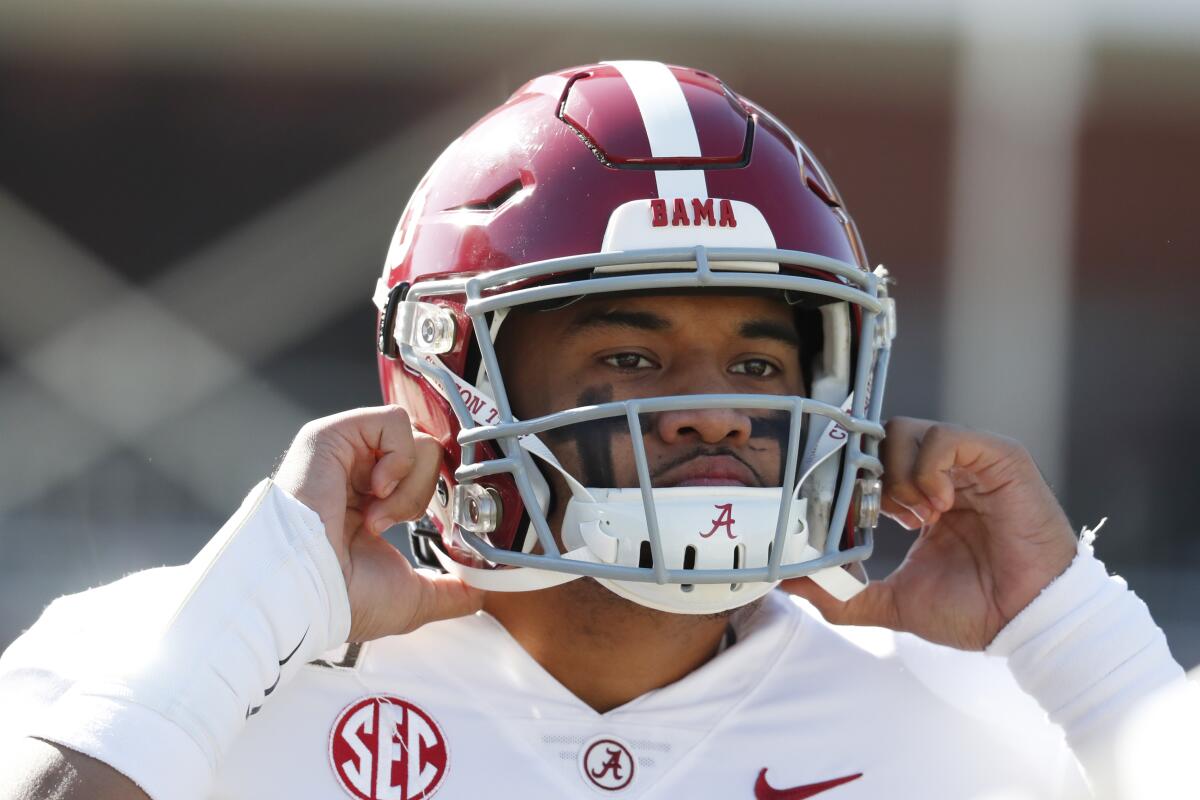
They have spent their last three years in football purgatory, mocked in the rare instances they weren’t ignored.
The Chargers received a break from the cycle of negativity Tuesday, as they unveiled new uniforms that were the subjects of near-unanimous praise.
The fact that a jersey reveal marks the greatest moment in Los Angeles Chargers history is problematic, but a win is a win, especially for a franchise found to be less popular than the Sparks in a recent survey conducted by Loyola Marymount University.
And there could be more.
Why the Chargers shouldn’t take quarterback in first round of NFL draft
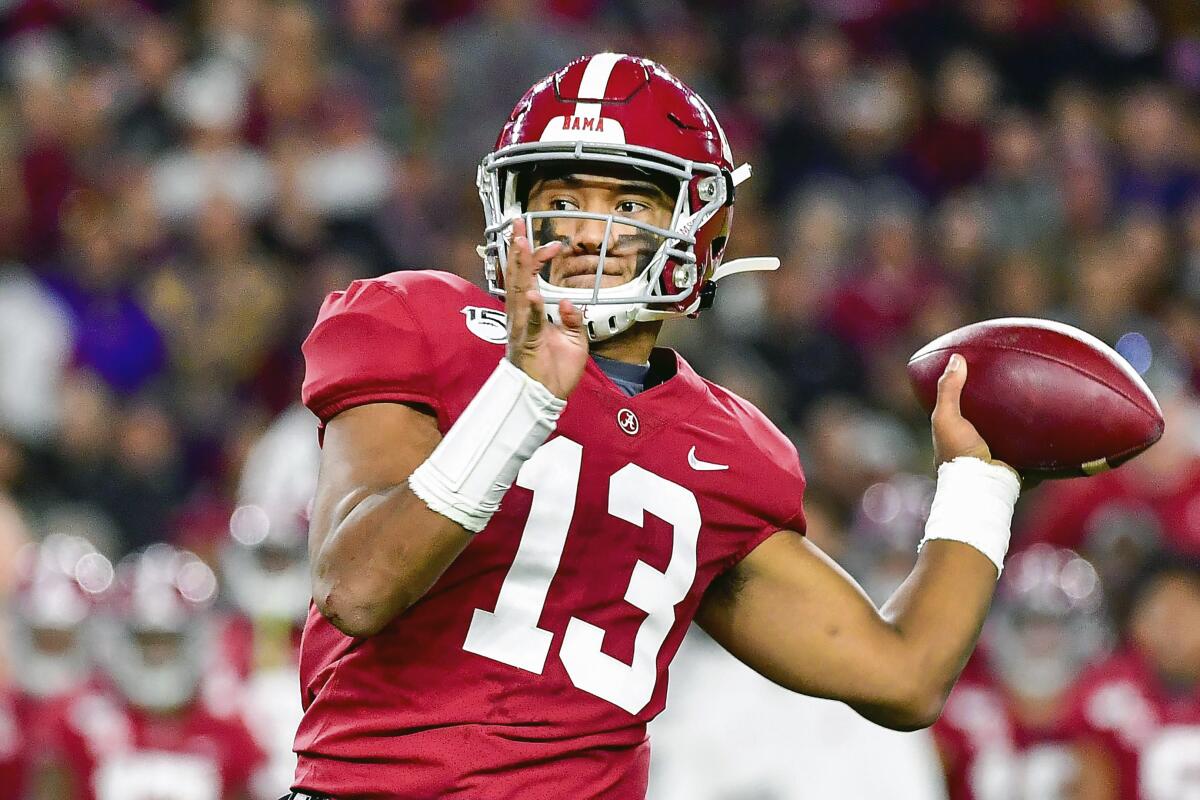
Young quarterbacks are lousy life preservers.
The Chargers shouldn’t use the No. 6 pick on a quarterback.
Some of those young talents pan out — more frequently they don’t — but if you’re looking to draft a prolific college passer to save your skin, good luck.
In the past five drafts, 16 quarterbacks have gone in the opening round. Unquestionably, there have been success stories, Patrick Mahomes, Deshaun Watson and Carson Wentz among them. But those players were taken by coaches who were safe in their jobs.
The Rams’ Jared Goff couldn’t rescue the coach who drafted him (Jeff Fisher). Neither could fellow first-rounders Jameis Winston (Lovie Smith), Marcus Mariota (Mike Mularkey), Mitch Trubisky (John Fox), Baker Mayfield (Hue Jackson), Sam Darnold (Todd Bowles), Josh Rosen (Steve Wilks) or Dwayne Haskins (Jay Gruden).
Texas A&M’s Justin Madubuike enters NFL draft with John Randle-like skills
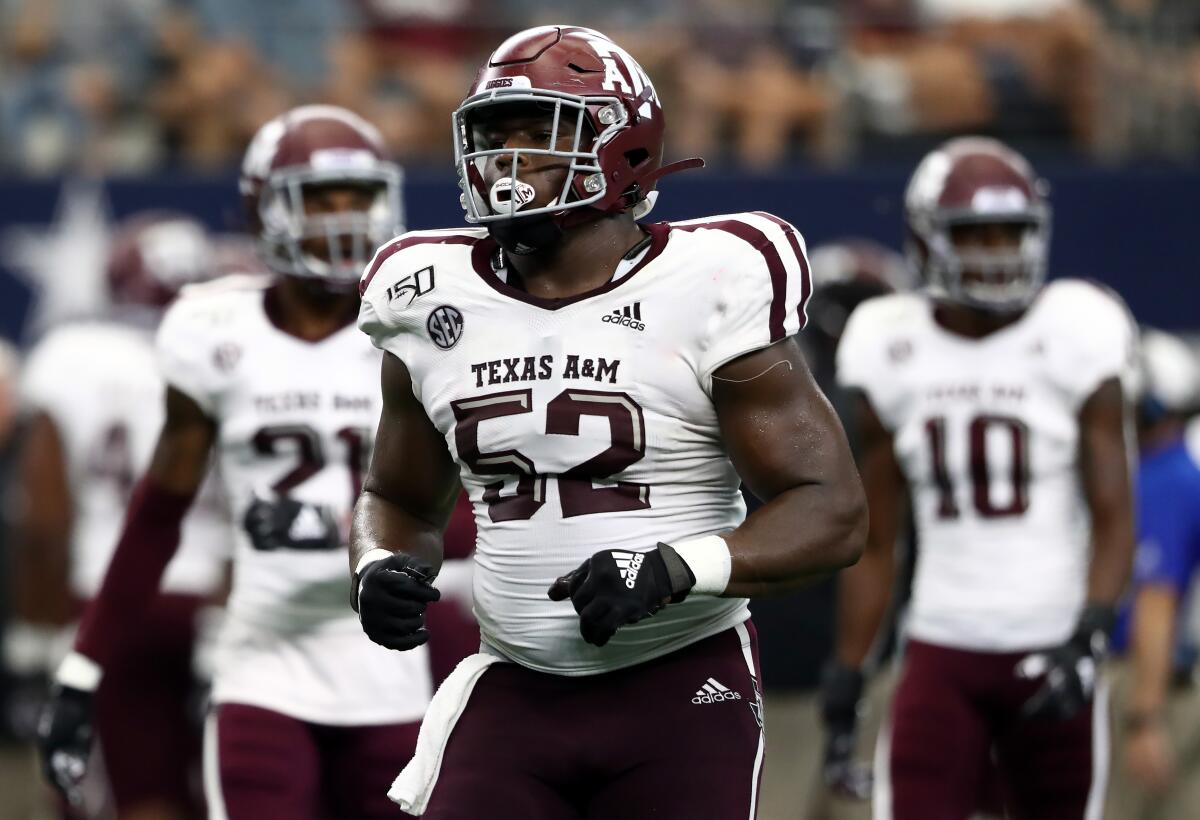
As a high school player wanting to model himself after one of the best to play his position, Justin Madubuike watched old footage of former Minnesota Vikings defensive tackle John Randle.
When Madubuike got to college, his position coach — presumably having similar thoughts about an NFL great whose technique could help — asked the defensive lineman to do some research on the Pro Football Hall of Famer.
At the recent NFL combine in Indianapolis, after all those years of studying the quick burst and relentless approach of his idol, Madubuike got to see all that greatness come to life.
Literally.
No introductions were needed when Randle materialized in front of his wide-eyed follower as one of the mentors for the top defensive line prospects for the upcoming NFL draft.
The All 32 NFL mock draft: Team reporters make first-round picks

With the NFL draft hours away, reporters who cover the teams on a daily basis take a crack at predicting how the first round will unfold in The All 32: The Times’ unique NFL mock draft experience. Each reporter makes a pick and gives a rationale for that selection.
The Cincinnati Bengals have the first pick of 2020 draft, and Tyler Dragon of the Cincinnati Enquirer made his selection. Be sure to check out the entire first-round rundown below.
The next ‘Slash’ out of Colorado? Laviska Shenault Jr. eager to be an NFL playmaker
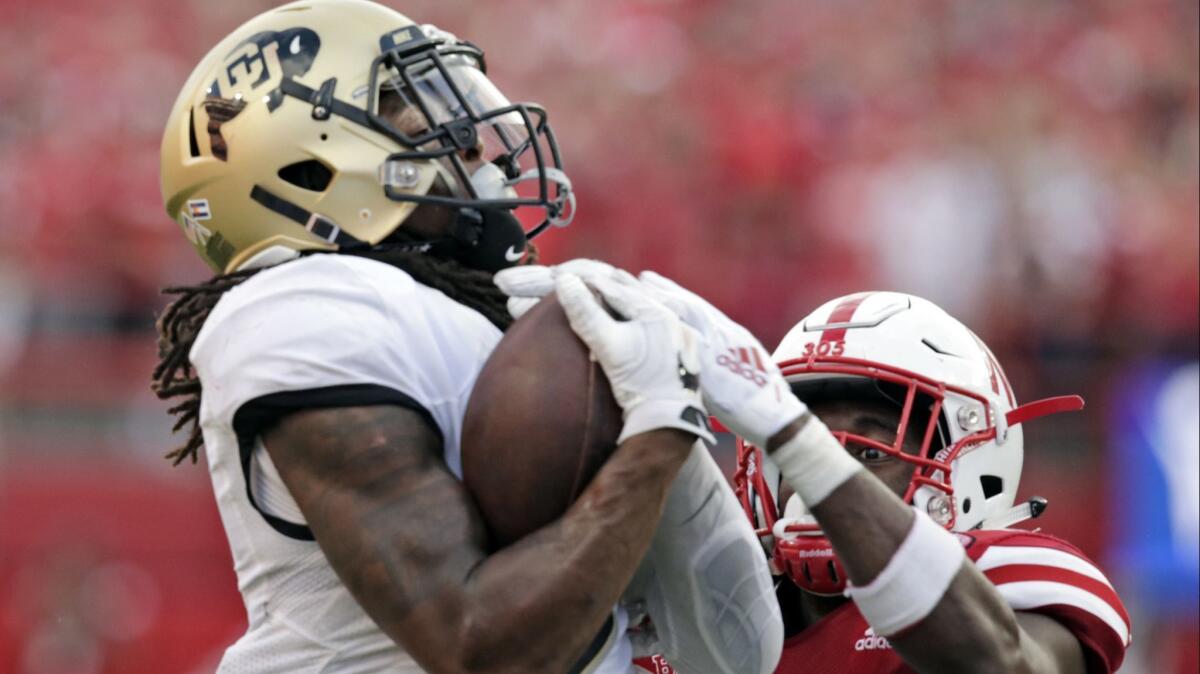
Charting how wide receiver Laviska Shenault Jr. went from the 73rd-ranked prep prospect at his position to one of the top college playmakers in the nation started with a conversation he had with his Colorado coaching staff after his freshman season.
The Buffaloes knew what they had in Shenault, the three-star recruit they snuck out of DeSoto, Texas. He had caught just seven passes his first year, so they decided they would come up with a way to make sure he got the ball.
“Coach was like, ‘We’re going to do wildcat,’ ” Shenault recalled. “And I’m like, ‘Oh, yeah! Let’s put that in now!’ ”
Shenault stormed into the spotlight his sophomore season in 2018 thanks in part to turning 17 direct-snap carries from the quarterback spot into five touchdowns. USC fans might remember his 49-yard sprint in the Coliseum and the Trojans chasing his trademark dreadlocks all the way into the end zone.
Utah State’s Jordan Love has exciting skills, but interceptions are a draft concern

He’s been called the most polarizing prospect in the NFL draft, a boom-or-bust quarterback with enough skills to be a Patrick Mahomes-like playmaker and enough question marks to be a Jake Locker-like disappointment.
Pro scouts love Utah State junior Jordan Love’s size (6-foot-4, 224 pounds), mobility and arm strength. They see tight spirals delivered from a variety of arm slots, 50-yard flick-of-the-wrist bombs into tight windows on the run, an ability to make off-schedule plays at the next level ...
Then they see the regression from his sophomore season, when Love completed 267 of 417 passes for 3,567 yards and 32 touchdowns with six interceptions, to his junior year, when he completed 293 of 473 passes for 3,402 yards and 20 touchdowns with a Football Bowl Subdivision-high 17 interceptions, and red flags are raised.
Did Love struggle because he was playing for a first-year coach in a second-tier conference with third-rate receivers? Or did last season reveal weaknesses in decision-making and accuracy that will be further exposed in the NFL?
There are no easy answers, which is why Love could be taken in the first 10 picks of the draft or drop to the third round.
Kenneth Murray Jr. faced childhood challenges that made him a man on the field

Kenneth Murray Jr. used his combination of size, speed, athleticism, instincts and tenacity to develop into a 6-foot-2, 241-pound tackling machine at Oklahoma and one of the top two inside linebackers, along with Louisiana State’s Patrick Queen, in the upcoming NFL draft.
Murray does not take any of his attributes for granted. When Kenneth was 11 years old in Missouri City, Tex., his parents — Kenneth Sr., a Baptist pastor, and Dianne, a retired police officer — adopted three children with chromosomal disorders.
Nyia, now 19, can speak and is relatively independent, but she reads at an elementary school level. Lenny, now 14, and James, now 11, are non-verbal and significantly undersized for their age. Lenny is confined to a wheelchair.
“One of the big lessons I learned is to be grateful for life, for the ability I have, for being able to function properly, to be able to speak,” Murray, who also has a younger biological sister, said at the NFL combine in February.
“It makes me want to go out there and give my best every time, because literally, on an everyday basis, I see my two little brothers who can’t do what everybody else can do. So I try to take advantage of every opportunity.”
Auburn defensive lineman Derrick Brown has grown into top NFL draft prospect
What do offensive linemen Drake Dorbeck of Southern Mississippi and Damien Lewis of Louisiana State have in common, other than weighing more than 300 pounds, playing football in the South and generally being known for adept pass blocking?
Well, both play a starring role in Derrick Brown’s highlight reel, which surely will be rolled out in the first 10 picks of the NFL draft when the Auburn senior defensive tackle’s name is likely to be called.
In 2018, Brown was only beginning to ascend draft boards when he pushed Dorbeck off the line of scrimmage and out of the way before lifting his 6-foot-5, 317-pound frame into the air with his arms outstretched and flying into Southern Miss quarterback Jack Abraham, who went splat.
A season later against LSU, the Brown hype machine was fully operational when he bulldozed Lewis and sent him tumbling into eventual Heisman Trophy winner Joe Burrow for the rare sack administered without touching the quarterback.
Personal tragedies prepared Penn State draft prospect Yetur Gross-Matos for the NFL

Twenty years ago, on a sunny afternoon in early May, Michael Gross dove into a Chesapeake Bay tributary to save his 2-year-old son. The boy, who’d fallen overboard, was saved. The father, 29, tragically drowned.
Nine years later, on a dark and cloudy night in Virginia, the same boy stood with his older brother on a baseball field. Rumbling thunder soon ended their Little League game, but Chelal Gross-Matos chose to continue playing catch. Lightning struck the field, killing Chelal, who was 12 years old.
More than a decade later, the boy who twice experienced unthinkable tragedy is one of the top edge-rushing prospects in the NFL draft, and one team after another asks him to describe the most difficult circumstance he’s endured.
Truth is Yetur Gross-Matos considers those he has lost every day.
A.J. Epenesa is ready to take NFL step after following father’s footsteps at Iowa
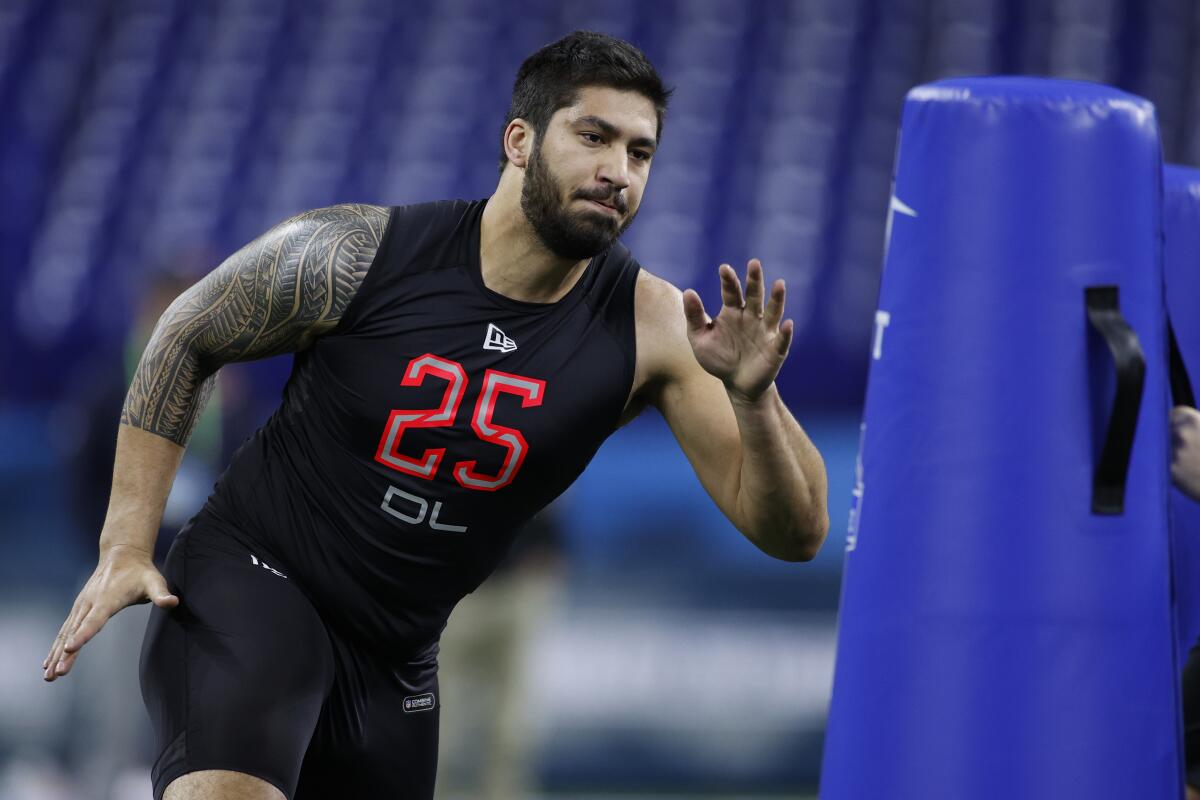
The drive from his hometown of Edwardsville, Ill., to the University of Iowa was just 273 miles for A.J. Epenesa, the 6-foot-5, 275-pound edge rusher who is expected to be a late first-round or early second-round pick in the NFL draft.
That was a mere hop, skip and a jump to college compared to the 6,370-mile journey his father, Eppy, took from American Samoa to Iowa, where the former defensive lineman earned a scholarship after making the Hawkeyes as a walk-on in 1995.
Eppy’s football career ended in Iowa City — he’s worked as a ground operations manager for Southwest Airlines at the St. Louis Airport for the last 19 years — but his son will move on to the NFL in part because of the training and tutelage Eppy has provided.
Ohio State 2,000-yard rusher J.K. Dobbins tells NFL teams he ‘can do it all’
Eddie George nearly got there. Ezekiel Elliott came pretty close too. Archie Griffin won two Heisman Trophies, the only player in history, but never made it.
Some of the best running backs in college football history have come through Columbus, Ohio, but none of them matched what J.K. Dobbins did at Ohio State last fall, when he became the first Buckeyes back to reach 2,000 yards rushing in a season.
When it comes to running backs, prolific college productivity is hardly a reliable predictor of pro success. Of the 29 backs in college football history to reach that 2,000-yard mark, more have flamed out than flourished. For every Barry Sanders (2,628 yards at Oklahoma State in 1986), there’s a Kevin Smith (2,567 yards at Central Florida in 2007) or a Ron Dayne (2,109 yards at Wisconsin in 1996), seemingly diminished by their workloads before they hit the NFL.
Only a handful of college backs carried the ball more than Dobbins over the past three seasons — fellow top Big Ten back Jonathan Taylor of Wisconsin being one. But as Dobbins sees it, after 796 touches and more yards than any Buckeye back outside of Griffin, he’s just getting started.
Read more >>>
What NFC, AFC West teams seek in NFL draft
The Times’ Sam Farmer analyzes team needs by divisions ahead of the NFL draft:
NFC West
Cardinals: Kyler Murray needed another good receiver, so the Cardinals went out and got the best — DeAndre Hopkins. Now, Arizona needs to protect its No. 1 overall pick with capable blockers. They are in prime position with the seventh selection to take the best offensive lineman, someone who can start immediately at right tackle.
49ers: This is a deep draft for receivers, and the 49ers have two first-round picks. They could be in position to take Jerry Jeudy or CeeDee Lamb, the two top wideouts in this class, or they can wait and take an offensive tackle instead. Left tackle Joe Staley is 35 and in the twilight of his career.
Staying for senior season at Oregon supports draft stock for quarterback Justin Herbert
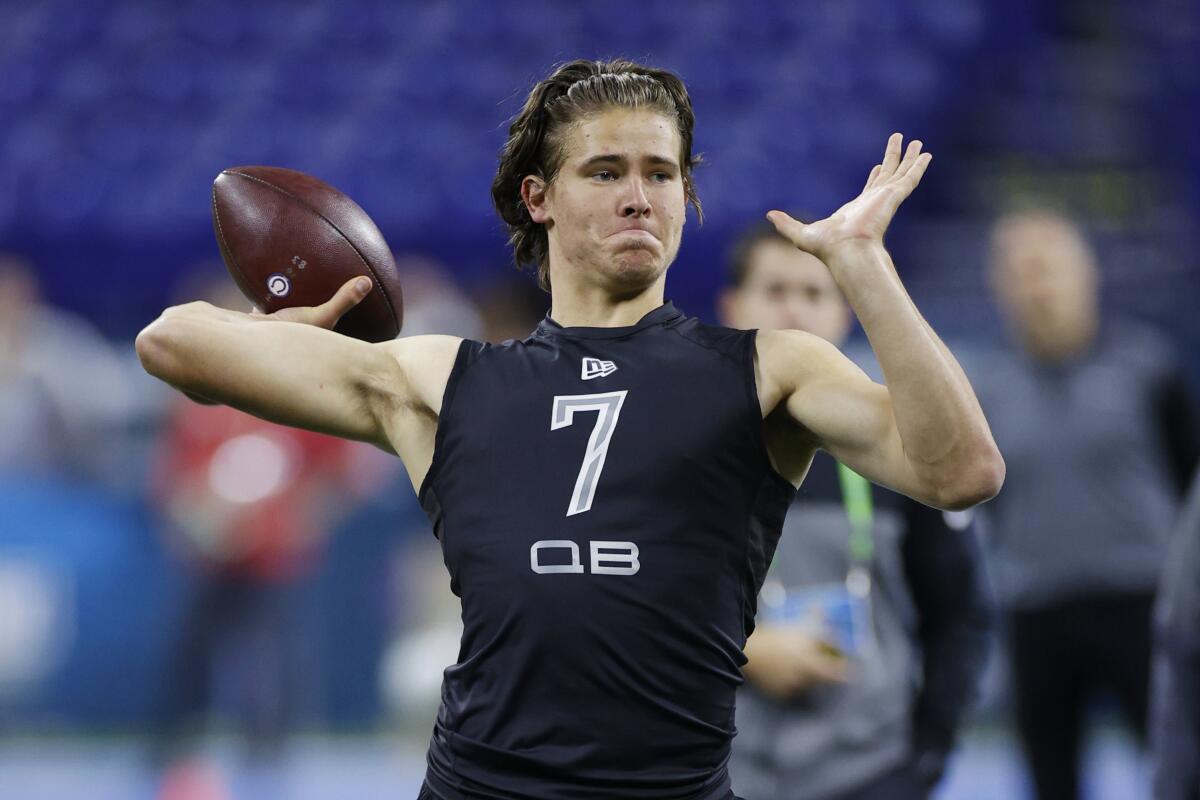
Justin Herbert seemed to have little to gain and plenty to lose by returning to Oregon for his senior season instead of turning pro.
Many projected the 6-foot-6, 236-pound quarterback as a top-five pick in the 2019 NFL draft, when the crop of top passers — Kyler Murray, Daniel Jones and Dwayne Haskins — did not appear as strong as this year’s group headed by Joe Burrow, Tua Tagovailoa, Herbert and Jordan Love.
Any slippage from a superb junior season in which he threw for 3,151 yards and 29 touchdowns could drop Herbert to the back of the first round or lower. A serious injury in 2019 could cost him millions of dollars.
But the chance to finish his career in hometown Eugene, Ore., and play with brother, Patrick, an incoming freshman tight end, was too alluring for Herbert.
After Joe Burrow at No. 1 of NFL draft, who gets Love?
Where is the Love?
Utah State quarterback Jordan Love is nowhere to be found in The Times’ final first-round mock draft. While it’s possible he could go in the top 10, Las Vegas could take him in the teens or New England could see him as the eventual replacement for Tom Brady.
In this draft, though, he’s waiting until the second round. There are plenty of pass catchers among the first 32 players selected, however.
Deceased dad of Michigan’s Cesar Ruiz is still at center of his draft dream

When evaluating potential investments, NFL general managers and scouts like to know a player is not a risk to lose motivation with the first big paycheck he receives. It helps, in that case, to play the game for a bigger purpose, which has never been a problem for Michigan center Cesar Ruiz.
Ruiz was 8 years old when his father, also named Cesar, was hit by a car on the side of a South New Jersey highway, ending his life at 26. The elder Cesar had reportedly pulled over to help another driver change a flat tire.
“This whole entire experience is dedicated to that whole situation, that tragedy,” Ruiz said at the NFL scouting combine. “I still do it, every night, every day, I think about it. If my dad was here to see what I’m doing right now, he would be mind-blown. So I’m still playing for my dad, I still play through my dad, my dad still lives through me. And that’s how it’s always going to be.”
It wasn’t just his father’s death that shaped the mentality of one of the draft’s top interior linemen, but how he died — being a good Samaritan.
ESPN’s Todd McShay recovering from coronavirus, won’t be part of draft coverage
ESPN draft analyst Todd McShay announced Thursday he is recovering from the coronavirus and will not be part of the network’s draft coverage.
Ohio State’s Chase Young in a rush to show what he can do in NFL
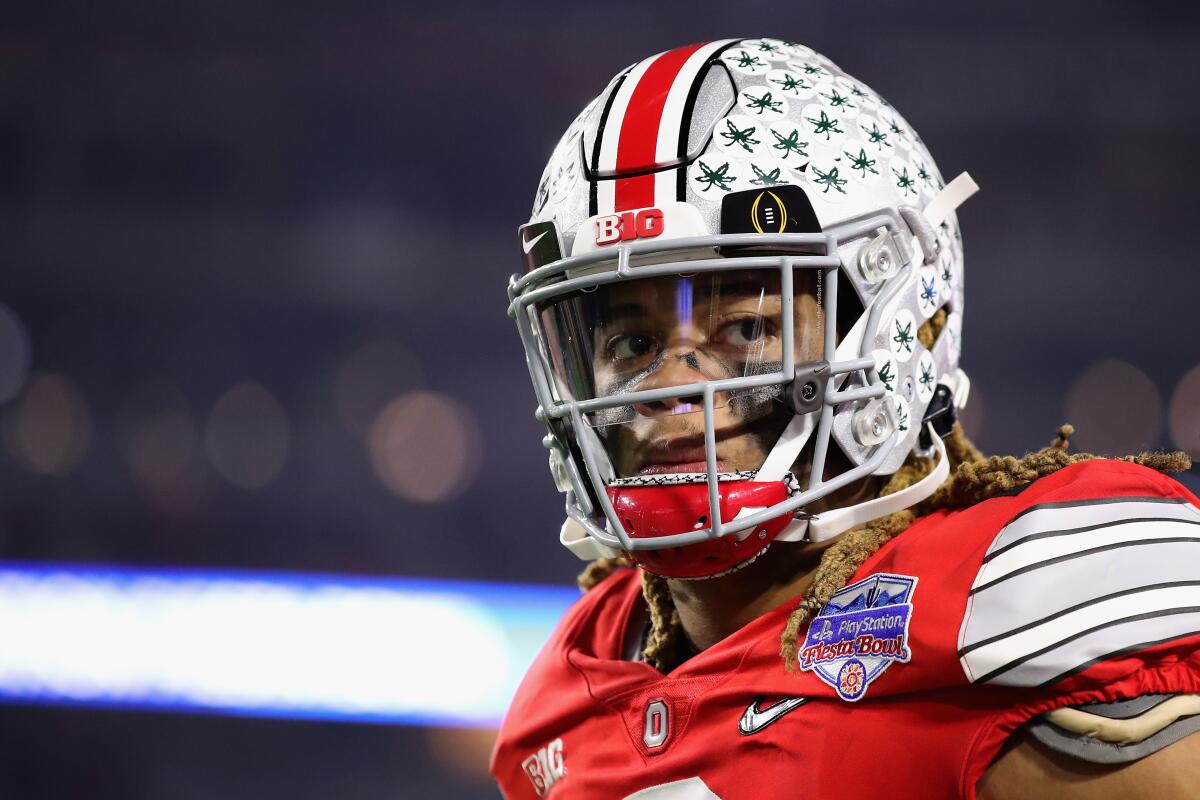
His elite size, strength, athleticism and length are rivaled only by his confidence. Chase Young is not expected to be the first pick in the NFL draft — that honor likely will go to Louisiana State quarterback Joe Burrow — but the Ohio State edge rusher has no doubt he is worthy of that distinction.
“I definitely think I’m the best player in the draft,” Young said at the NFL combine in Indianapolis in February. “I think I showed it on my tape. You can go to every game. I think I bring the whole package as a defensive end.”
It would be fruitless to compare a potential franchise quarterback with a game-wrecking edge rusher. The physical demands, tool sets and roles of the positions are completely different.
But if you had to order Burrow and Young on a draft board, a compelling case could be made for the 6-foot-5, 265-pound beast who will be paid handsomely to chase down gunslingers such as Burrow on Sundays.
Alabama receiver Jerry Jeudy appears to be top catch of NFL draft
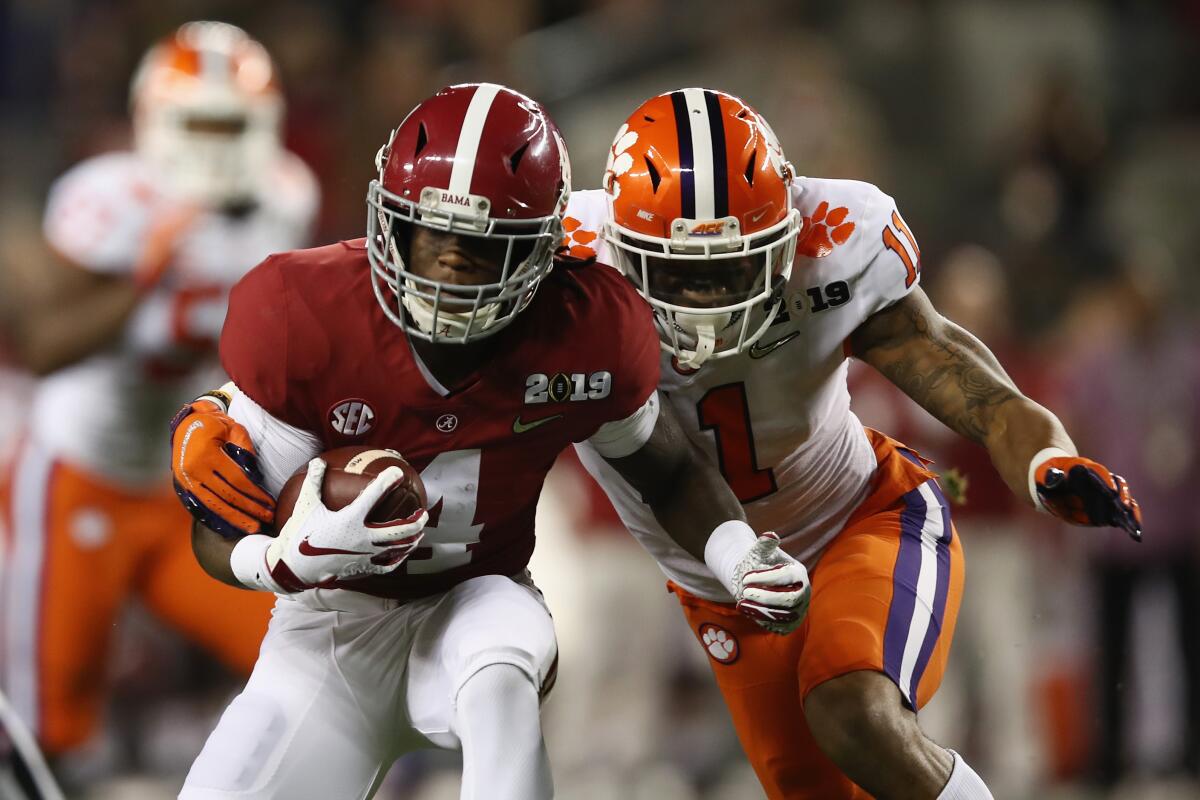
As a senior at Deerfield Beach High School, Jerry Jeudy was walking off the field after leading his team to a berth in the Florida state semifinals when his older brother, Terry, stopped him. He had something to tell Jerry that would shake him to his core — and shape everything that was to come for the standout wide receiver.
Aaliyah, their 7-year-old little sister, was gone.
Jerry had her whole life to prepare for this moment — Aaliyah had been born with complications that kept her from walking or talking — and the fact she had lived so long was a miracle. But Jerry collapsed to the turf under the weight of the news and cried with his brother.
“I love you sis, you in a better place now, I swear I’m going to make it for you and mommy,” Jeudy tweeted the next day.
Roger Goodell gives a tour of his NFL draft war room
NFL commissioner Roger Goodell won’t have the luxury of hearing fans boo him at the NFL draft this year, but that’s not stopping him from playing his usual role in announcing picks.
Hunkered down in his home in Bronxville, N.Y., Goodell tweeted a video tour of the basement war room he’ll be using as his central command during the draft, which starts at 5 p.m. PT. Goodell, as expected, has a pretty nice setup for getting his announcements to the masses.
The draft was originally scheduled to be held in Las Vegas this week until the COVID-19 pandemic derailed those plans. While Goodell looks to be a safe distance from the coronavirus, it remains to be seen if fans will get creative in finding new ways to boo him on social media.
Clemson’s Isaiah Simmons can tackle any position on defense
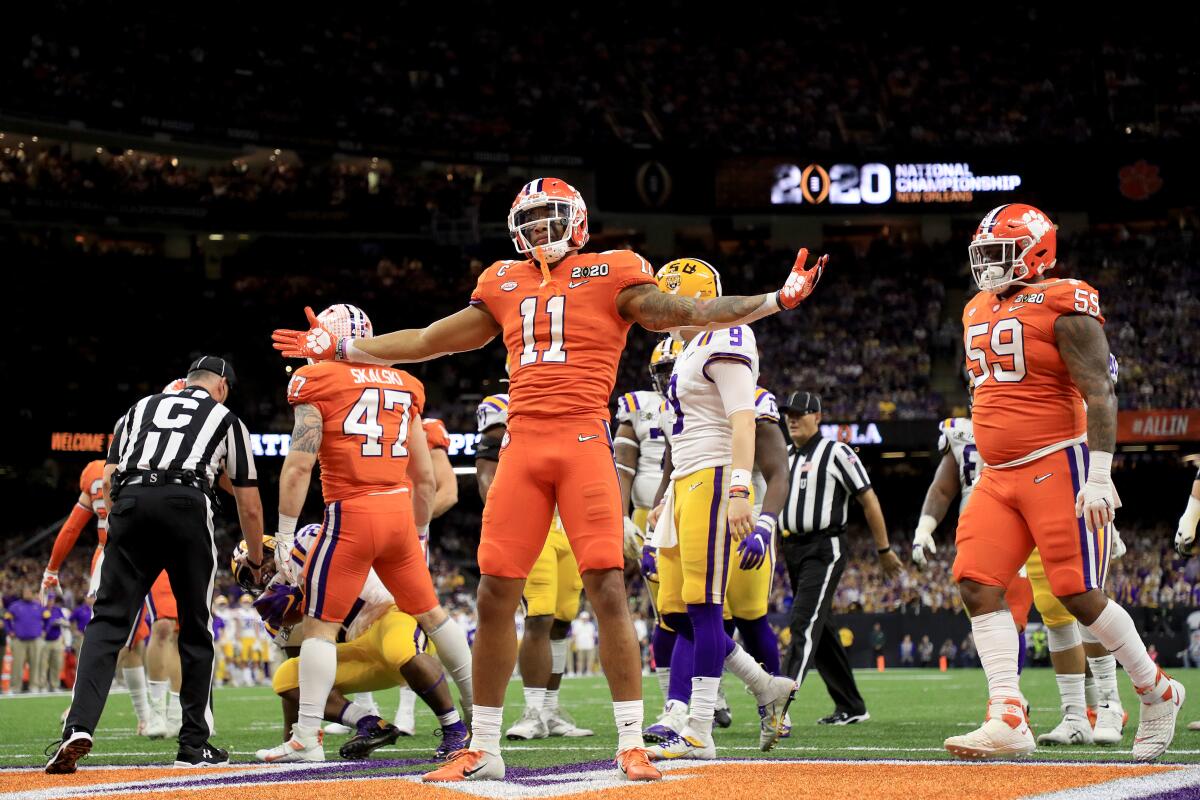
Isaiah Simmons offered one word when asked what position he plays.
“Defense,” Simmons said at the recent NFL combine.
He wasn’t being flip. A positionless wonder out of Clemson, Simmons has played edge rusher, linebacker, cornerback and safety.
Truth be told, his talents can’t even be confined to defense. Coming out of high school, he was a star receiver. He’s played as many as five positions in a single game.
Can anyone catch Oklahoma receiver CeeDee Lamb?
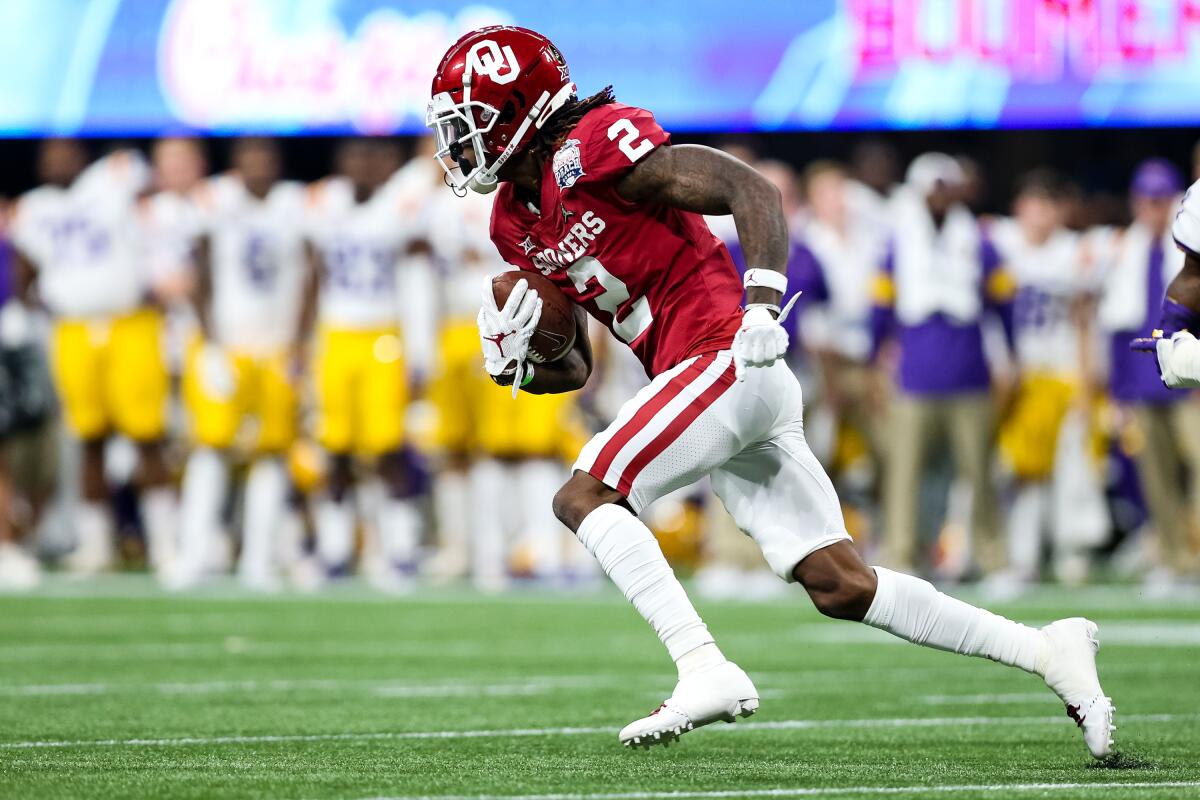
In a potentially historic class of receiver prospects, it doesn’t hurt to have one skill that stands above the rest.
Oklahoma’s CeeDee Lamb might be the most complete receiver in this draft anyway, with speed and strength to overwhelm defenders, poise and instincts to outwit them, and three years of production in one of the nation’s most explosive offenses. There’s a reason he’s elicited comparisons to the likes of DeAndre Hopkins and Davante Adams, two perennial NFL Pro Bowl selections at the position.
But to see what truly separates Lamb, just give him the ball. Give him a sliver of space. And let him go.
“I enjoy making people miss and making the most of every opportunity I get,” Lamb said at the NFL scouting combine in February.
What NFC, AFC North teams seek in NFL draft
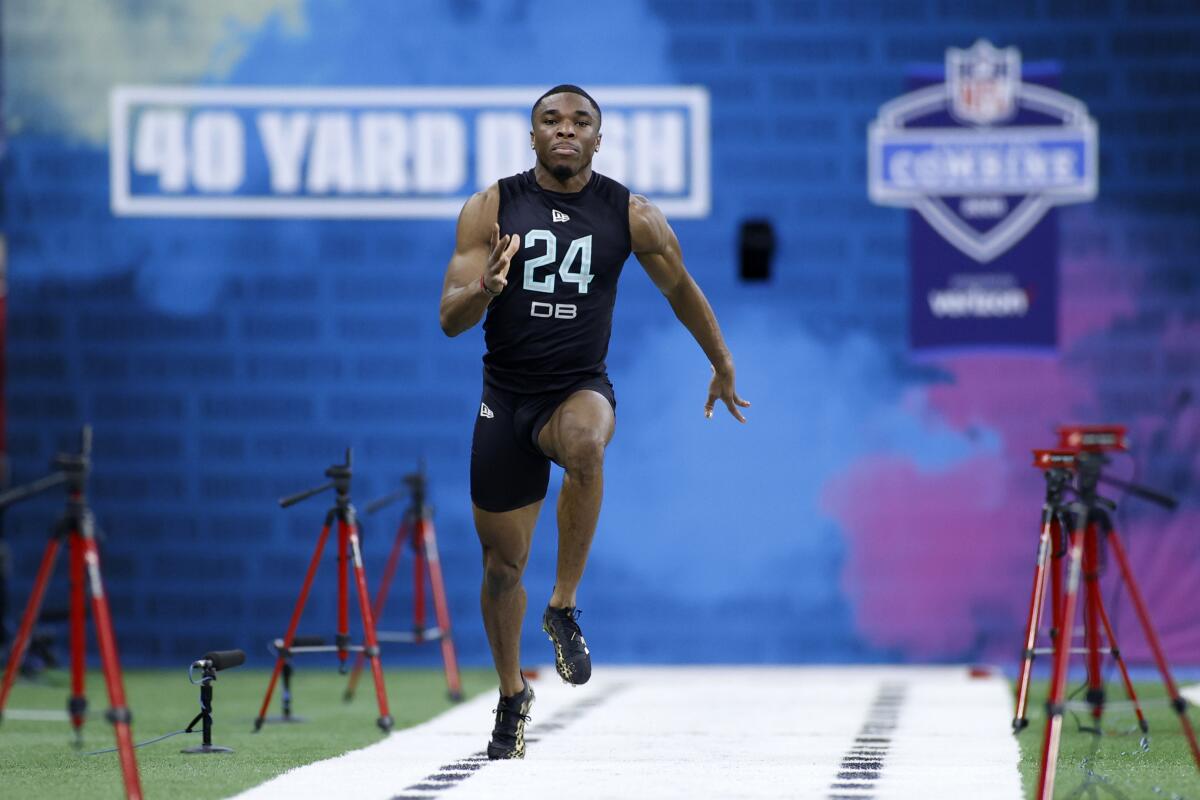
The Times’ Sam Farmer analyzes team needs by divisions ahead of the NFL draft:
NFC North
Lions: With the third pick, the Lions are in prime position to trade down with a team badly in need of a quarterback. But is there any team willing to give up the necessary picks? Having traded Darius Slay, Detroit needs help at cornerback. Theirs was the lowest-interception rate of any defense, and Ohio State corner Jeff Okudah could help right away.
Vikings: Two selections in the first round mean the Vikings can address their needs at cornerback and on the offensive line. For a Mike Zimmer-coached team, it was uncharacteristically mediocre against the pass last season. The interior of the offensive line is suspect, and could be improved with a young tackle who could move inside.
A top pick in NFL draft? Ohio State corner Jeff Okudah has it covered

Over the past two decades, as the value of shutdown cover men skyrocketed and salaries soared accordingly, the pass-happy NFL has been surprisingly conservative when it comes to selecting cornerbacks at the top of the draft. Just three have been drafted in the top five this decade. Just three in NFL history have been drafted in the top three.
Jeff Okudah is primed to be an exception to that rule. That’s how good the Ohio State cornerback was in his lone season as a full-time starter. If the Detroit Lions stay put with the third overall pick, Okudah could be the first cornerback since Shawn Springs in 1997 to enter that rarefied air.
Those are lofty expectations to place on a cornerback whose first collegiate interception came last September. But the former blue-chip high school prospect and collegiate All-American has welcomed that pressure since February, when he first copied the combine numbers of Patrick Peterson and Jalen Ramsey onto a whiteboard in his apartment, with the intention of besting both.
He already had copied bits and pieces from the corners, combining their skills with characteristics of other elite cover men in hopes of molding himself into the kind of cornerback NFL scouts might design in a lab.
LSU quarterback Joe Burrow goes from underdog to top dog entering NFL draft
Depending on which parts of Joe Burrow’s story one sees, he can be cast easily as a front-runner — a four-star recruit out of high school, top 10 nationally at his position, a Heisman Trophy winner and national champion, and now the projected No. 1 overall pick in the NFL draft.
But pull on other strands of Burrow’s yarn and his is a classic underdog’s tale — a quarterback who did not win the starting job in three years at Ohio State and chose to transfer, a junior starter at Louisiana State who completed less than 60% of his passes, and a pro prospect who elected not to throw or work out at the NFL scouting combine, knowing his skills would only be picked apart.
“My physical traits are limited compared to some of the guys here. Everyone can see it,” Burrow said during his combine interview. “I have to be smarter. I have to prepare better, and I have to know what’s happening before it happens so I can play fast.”
Which teams are most likely to make a trade in the NFL draft?
After the transcendent Heisman Trophy quarterback and the generational pass rusher, the fate of this week’s NFL draft hinges on a franchise-defining decision from a franchise defined by its poor decision-making.
For the Detroit Lions, there are no obvious choices at third overall. Ohio State cornerback Jeff Okudah is the presumed favorite to be the pick, after the Lions shipped away its top cover man this offseason. There’s also freakish Clemson defender Isaiah Simmons or Auburn defensive tackle Derrick Brown to consider, both of whom could make an immediate impact on one of the league’s worst defenses.
But the most sensible option may be to not pick at all. With top quarterback prospects Tua Tagovailoa and Justin Herbert both expected to be available, the Lions have the leverage to trade down, add picks, and potentially still draft one of the defensive prospects they most desire.
With no NFL draft pick until late in Day 2, will Rams be tempted to trade up?

Eight years ago, the Rams made defensive lineman Michael Brockers the 12th pick of the NFL draft. Two years later, they selected defensive lineman Aaron Donald with the 13th pick. And in 2016, the Rams traded to the top of the draft to pick Jared Goff No. 1.
Those three first-round picks are still on the Rams roster. Cornerback Jalen Ramsey and presumptive edge rusher Leonard Floyd are other first-round picks acquired by a team attempting to bounce back from a 9-7 finish.
But the October 2019 trade that brought Ramsey to Los Angeles cost the Rams first-round picks this year and in 2021.
So barring a draft-day trade, when the NFL draft begins Thursday, the Rams will be first-day spectators for the fourth year in a row.
What NFC, AFC East teams seek in NFL draft
The Times’ Sam Farmer analyzes team needs by divisions in four parts ahead of the NFL draft. Today Part 1, the East in order teams will draft:
NFC East
Redskins: With Ron Rivera as head coach and Jack Del Rio as defensive coordinator, it’s logical to think Washington will be focused on building a defensive beast. That likely will start with Chase Young, the top defensive talent in this draft. But a lot of quarterback-needy teams might want to trade into that No. 2 spot. And do the Redskins really have an answer at quarterback?
Giants: The Giants need playmakers on defense. Markus Golden was their only player to reach five sacks last season. They can get a stud with the fourth pick. Then again, they still need to fortify the wall of protection for second-year quarterback Daniel Jones, so offensive lineman is a possibility too. At this point they have a line as porous as cheesecloth.
What NFC, AFC South teams seek in NFL draft
The Times’ Sam Farmer analyzes team needs by divisions ahead of the NFL draft:
NFC South
Panthers: Carolina has moved on from Cam Newton and signed quarterback Teddy Bridgewater, so the Panthers are fine there. They might turn their attention to defense with the seventh pick, and defensive tackle Derrick Brown could really help a unit that was trampled last season. The Panthers had the league’s worst run defense in 2019.
Buccaneers: The Buccaneers are delighted to have signed Tom Brady, and that Hall of Fame-bound quarterback will be more thrilled if his new team gets him some blocking. Offensive tackle is the likely direction Tampa Bay will go with the 14th pick. Edge rusher is a need too.
Here’s everything you need to know going into the NFL draft

The NFL draft is finally here!
All of those mock drafts undoubtedly will soon be mocked. All of that guessing is likely to turn into second guessing.
For only the second time in weeks, we will have a live sporting event (of sorts) to follow.
The draft will be broadcast live on ESPN, ESPN Deportes, ABC and the NFL Network. It can also be viewed on WatchESPN, NFL Mobile and other streaming services.
What will this year’s draft actually look like?
What once was “Are you ready for some football?” has become, “Can you hear me now?”
As part of its unprecedented virtual draft production amid the COVID-19 pandemic, the NFL has sent “tech kits” to 58 prospects around the country. Each kit features various ring lights, tripods and microphones, along with two iPhones, allowing those future pros to turn their homes into makeshift TV studios.
If this draft were a wheel, NFL Commissioner Roger Goodell would be the hub — broadcasting from the basement of his New York home — with nearly 200 spokes fanning out to the 32 teams, those 58 prospects, and a collection of current and former players. Those feeds will be collected by video call centers and then will be sent in batches to ESPN.
“We’re doing it live,” said Michelle McKenna, the NFL’s chief information officer. “It’s not like we get to record it, and edit it, and make sure the sound and lighting is perfect. We’re going straight to live.
“It’s exciting, and very nerve-racking as well.”
